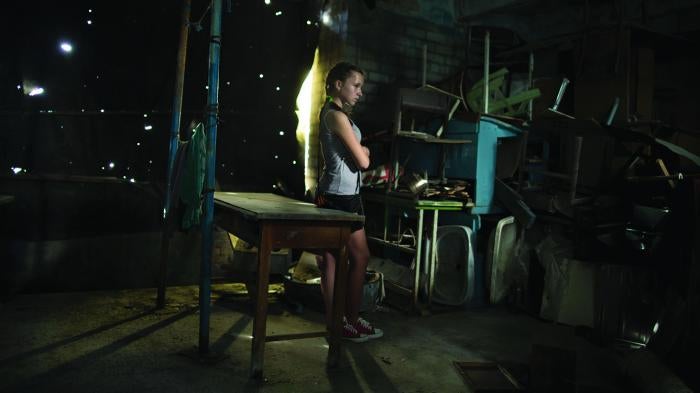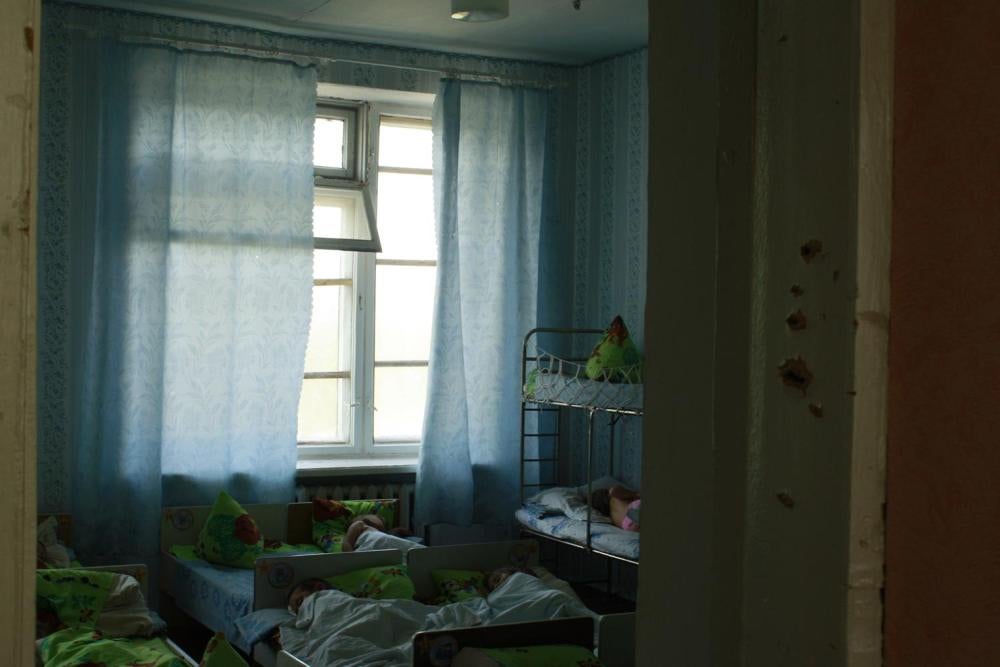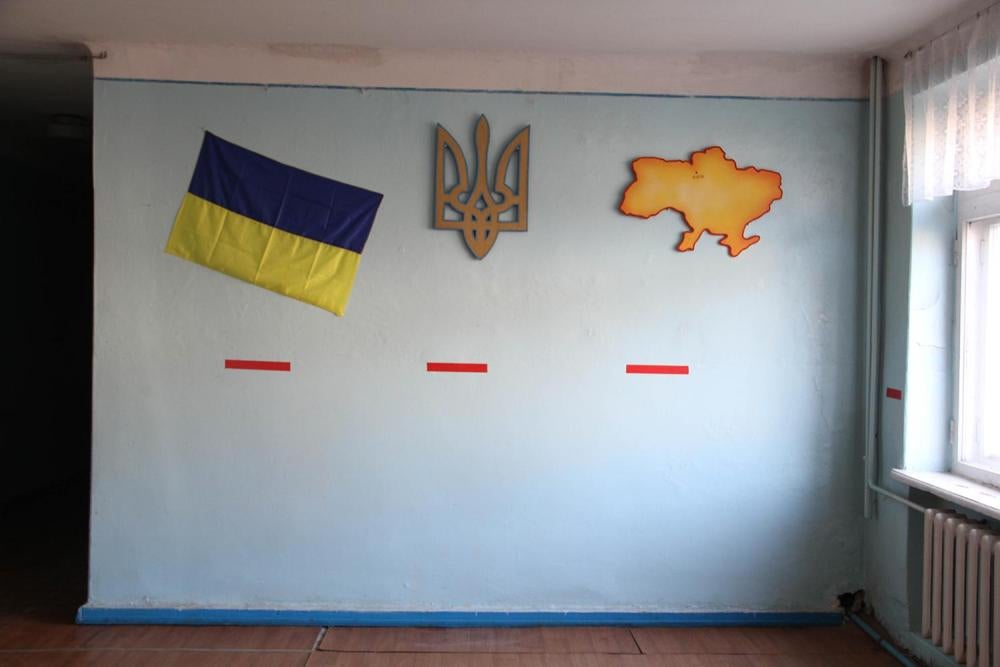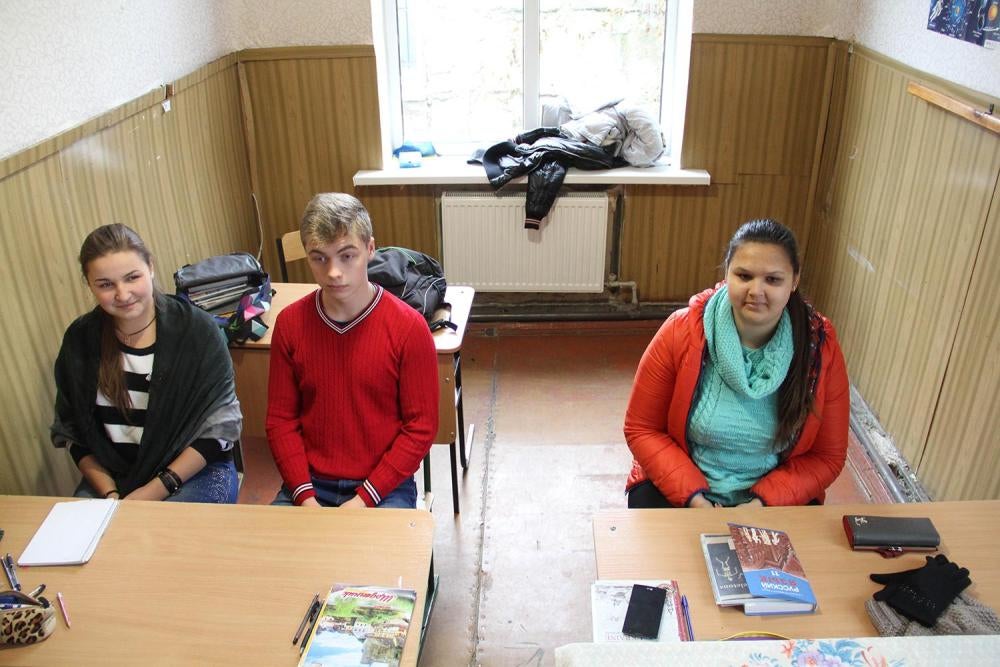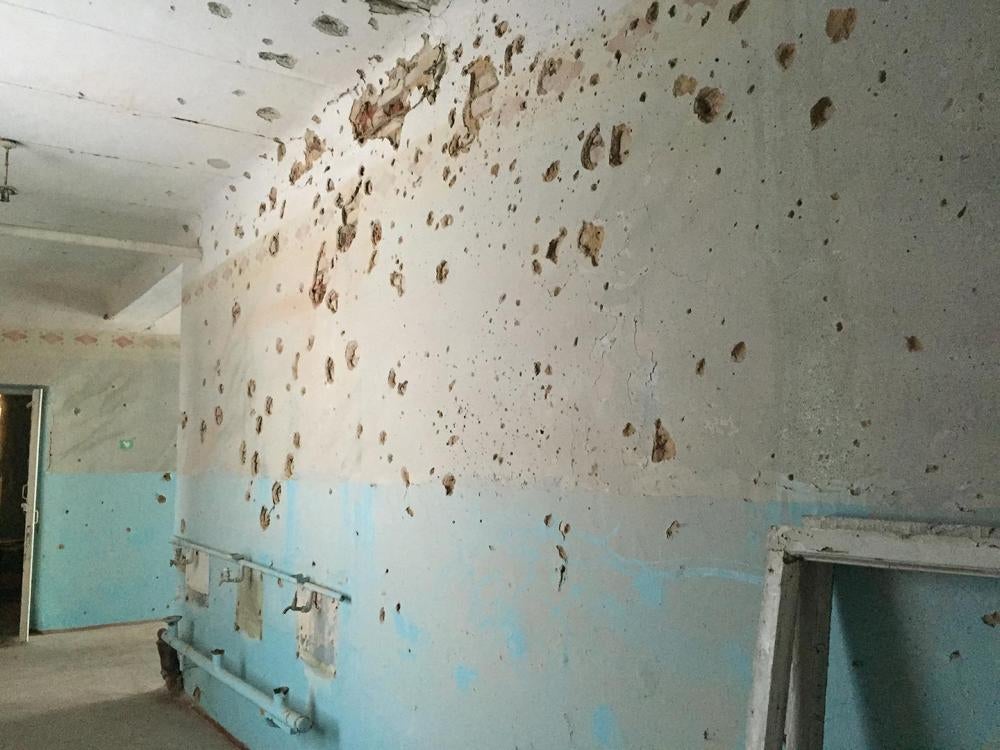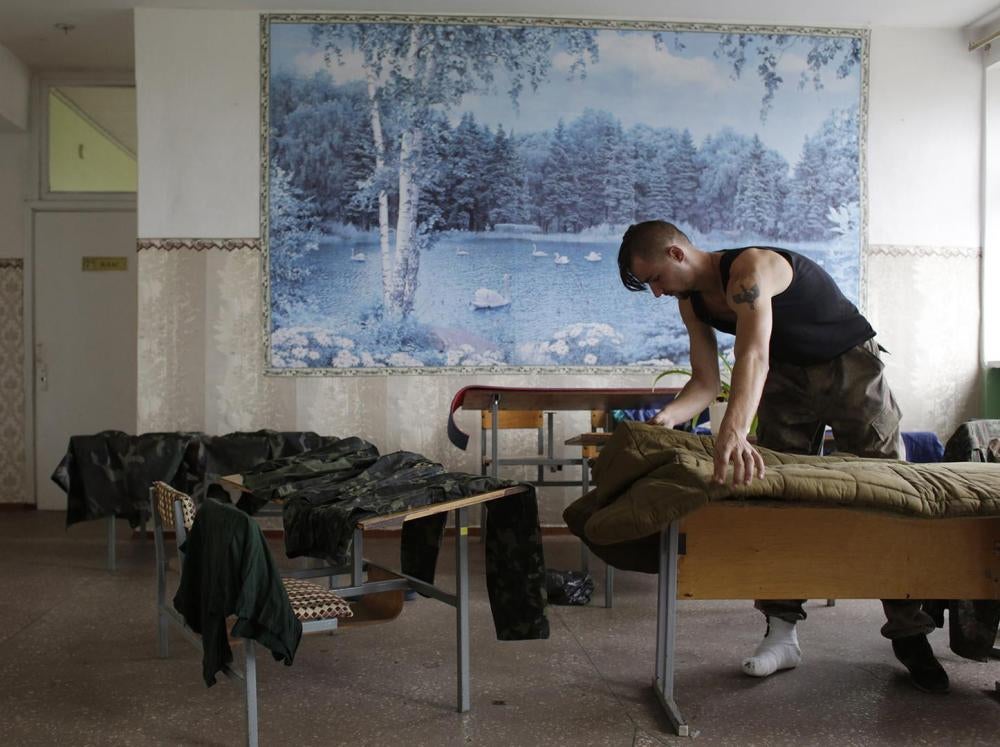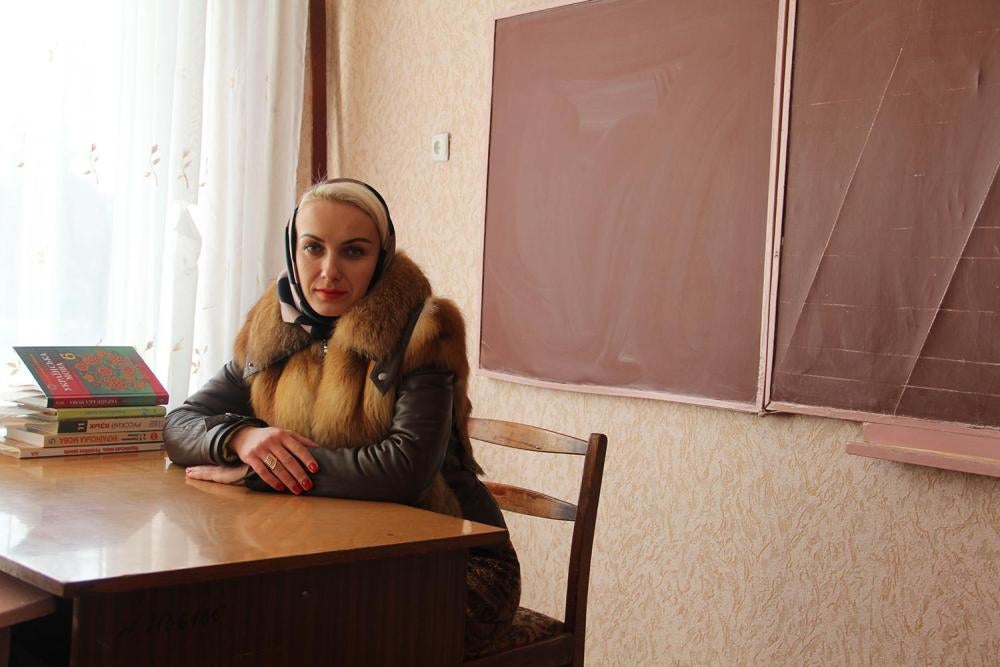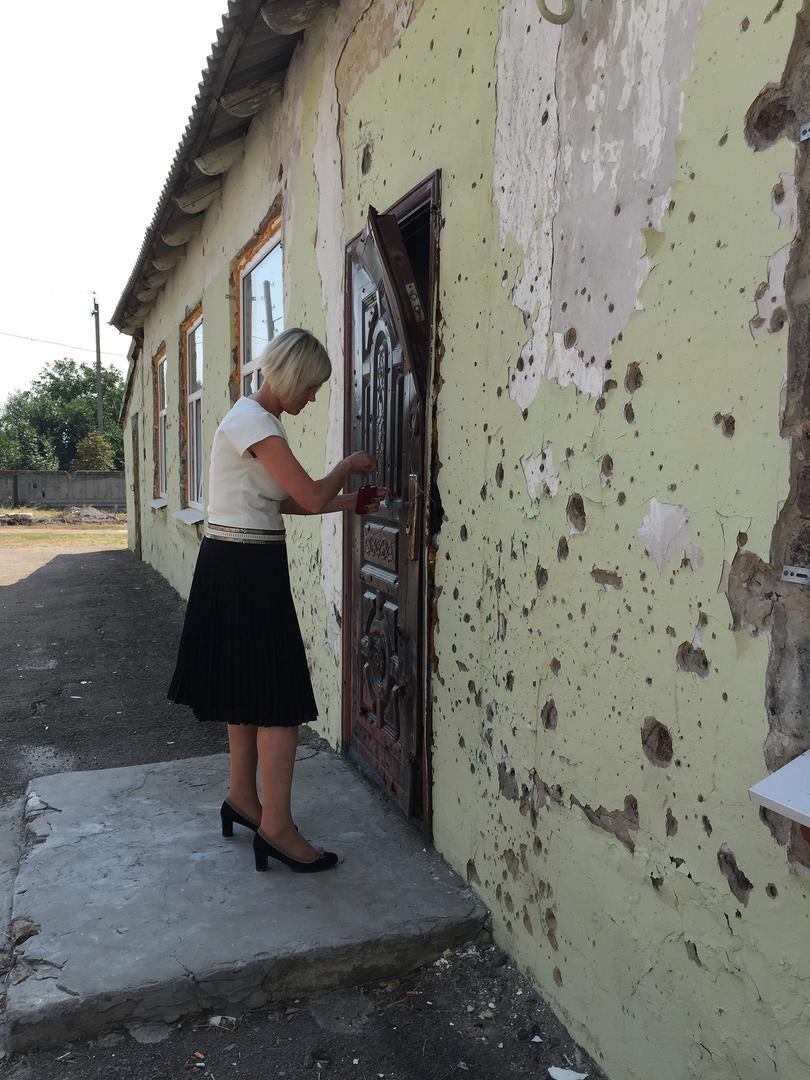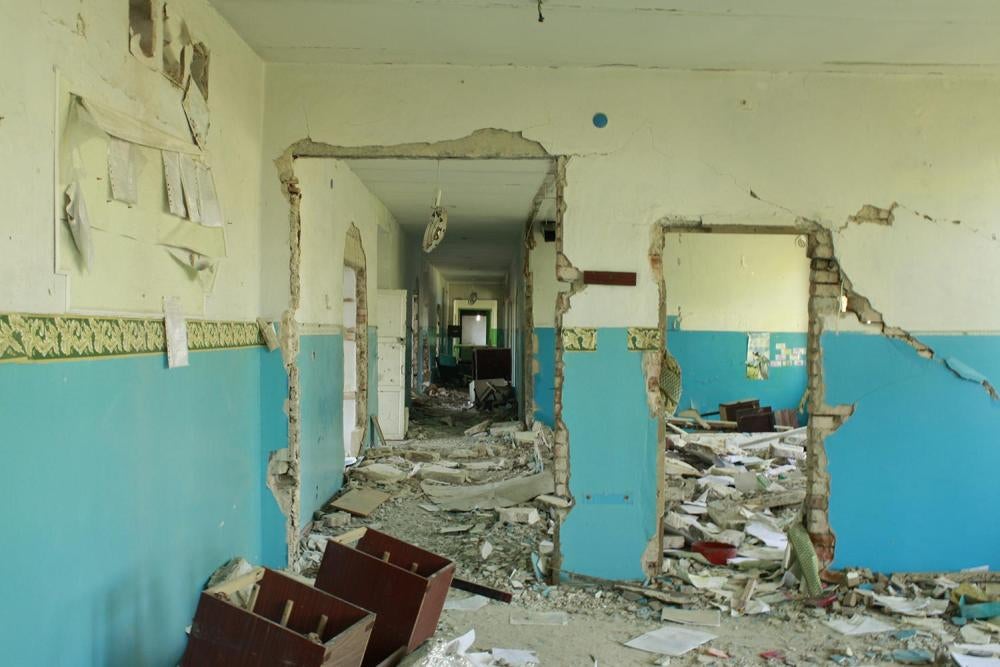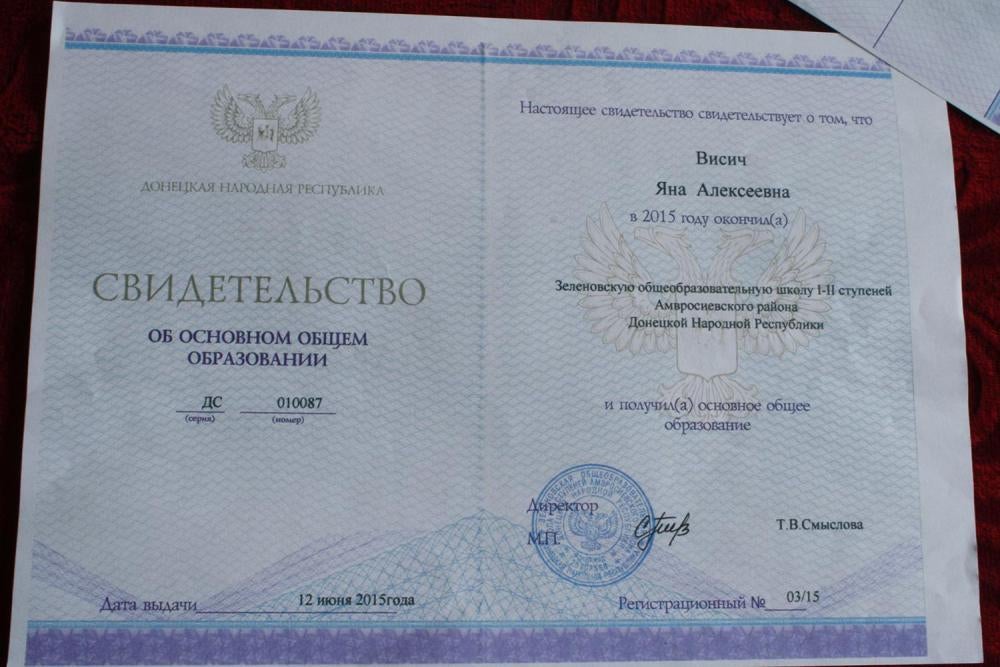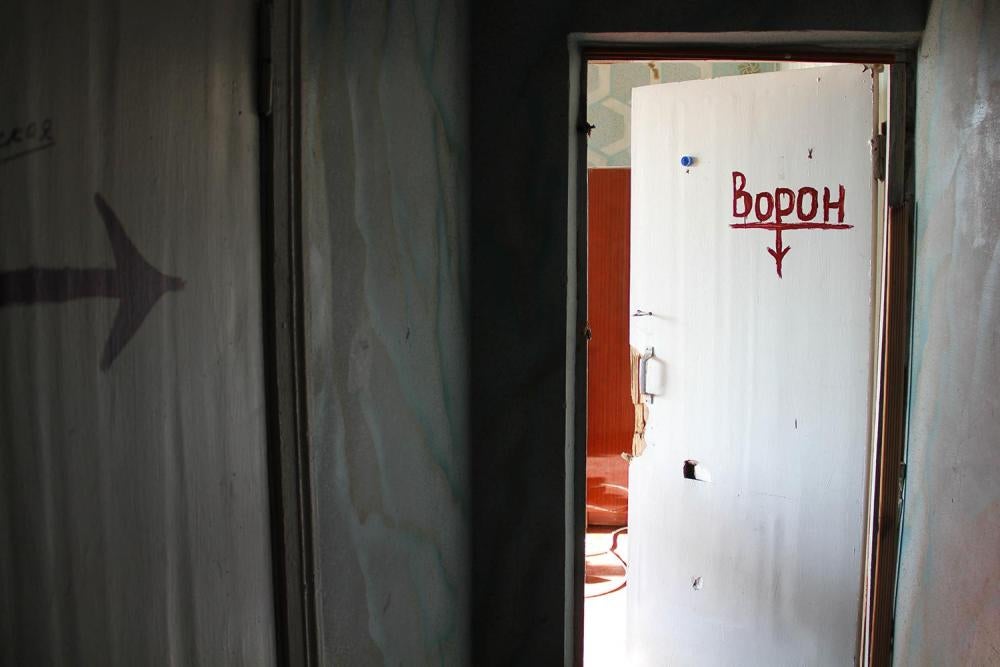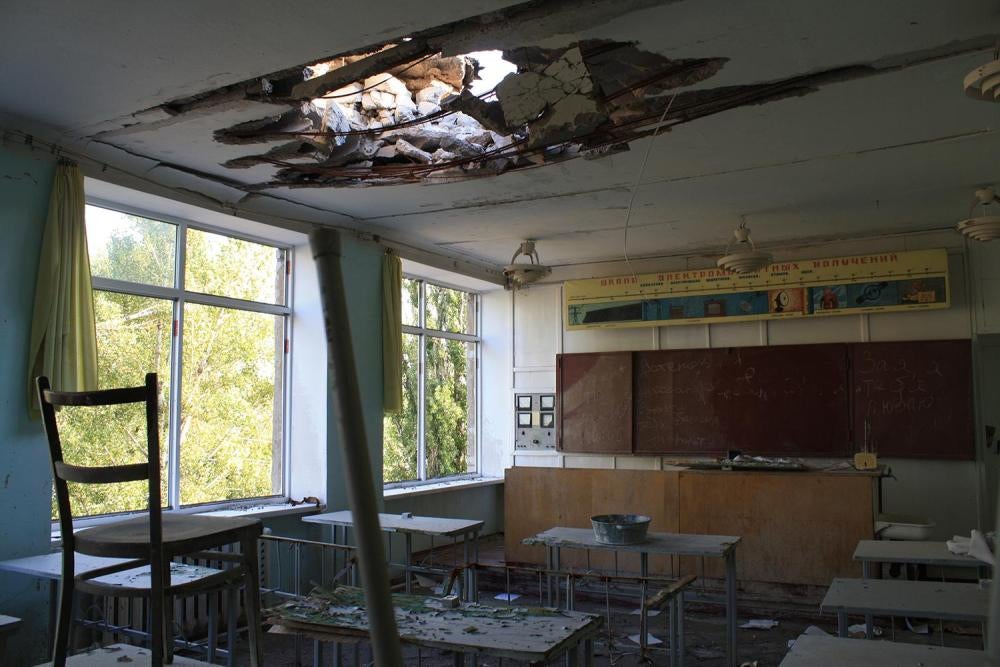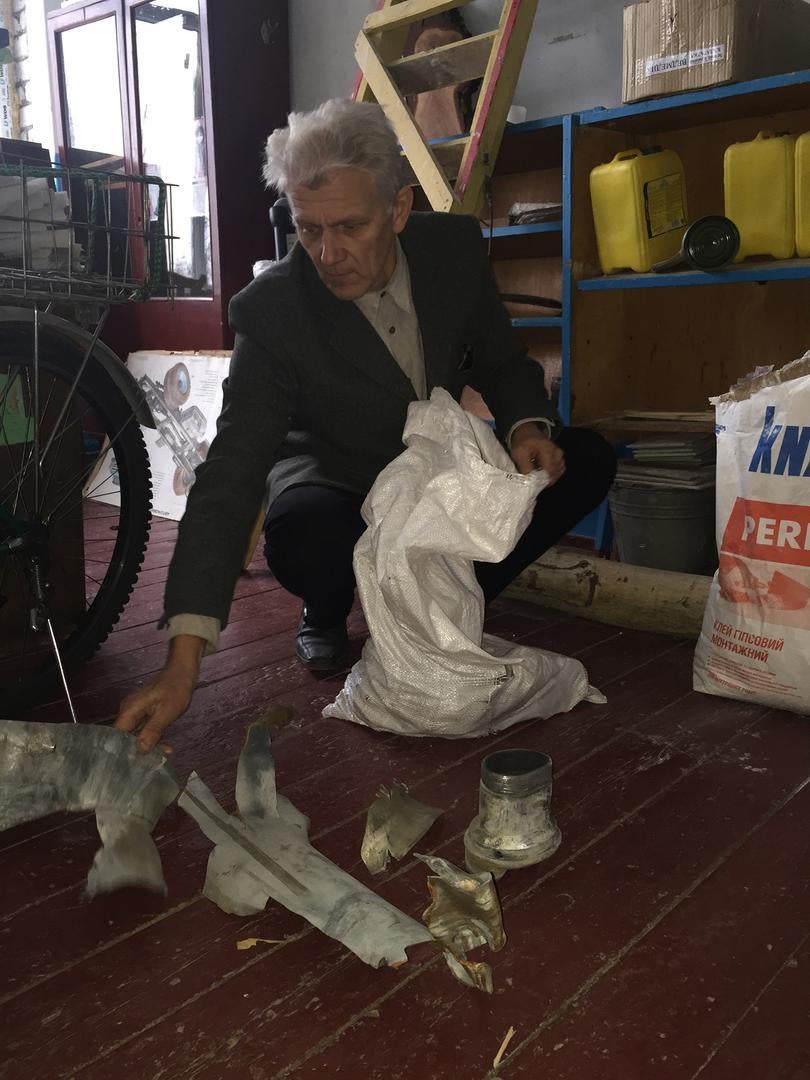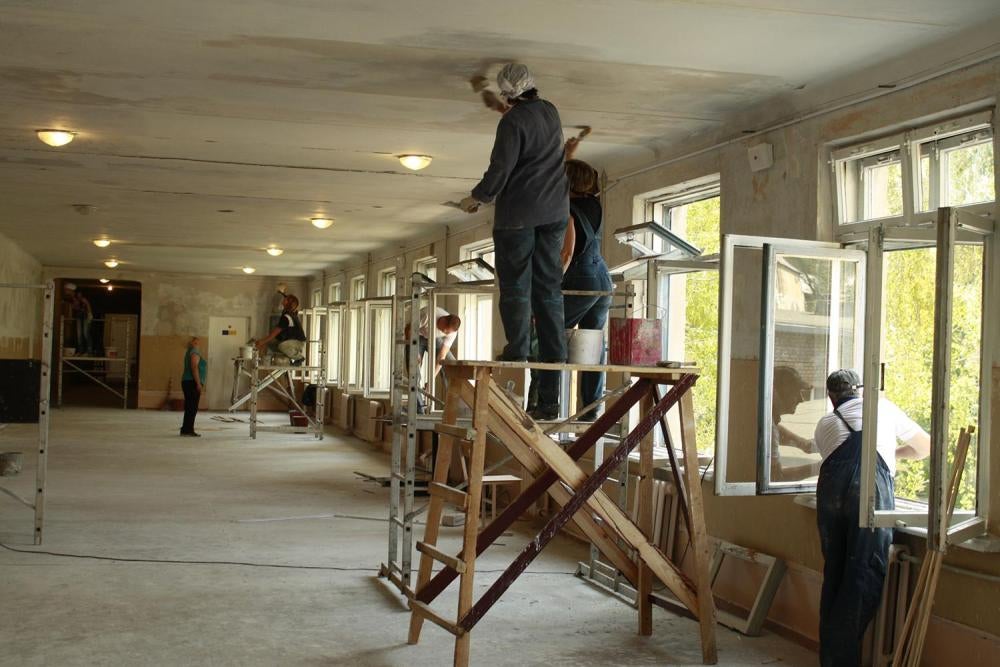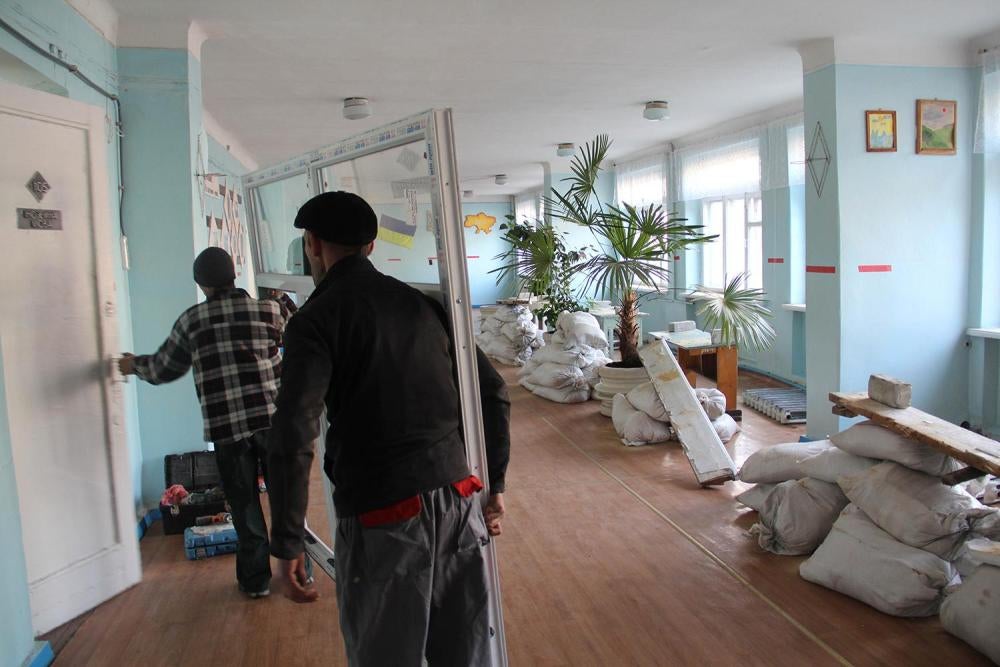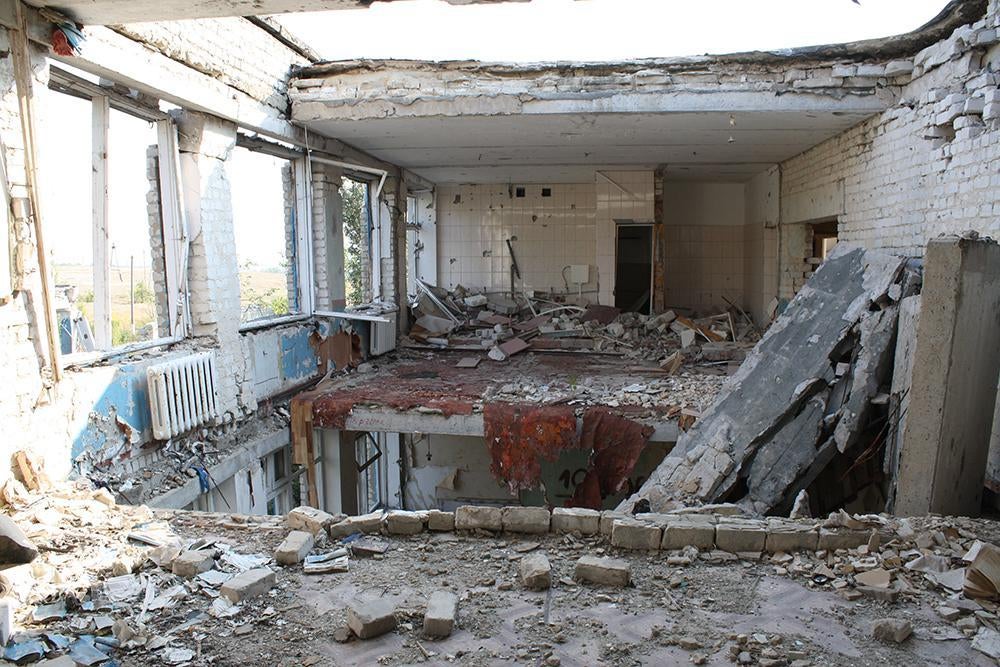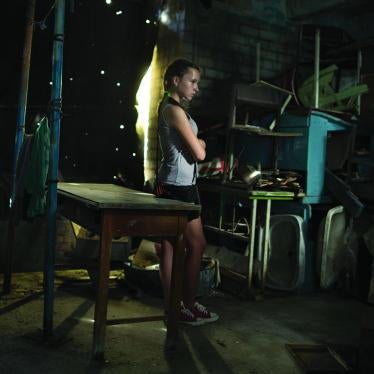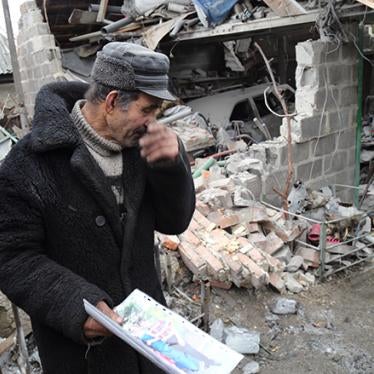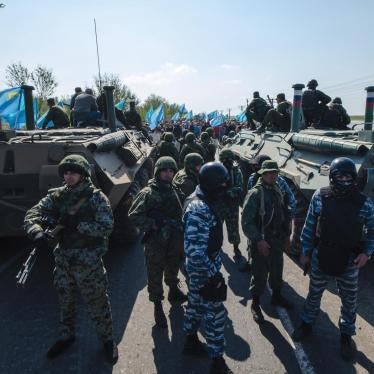Summary
The fighting was right in the city center. Our school changed hands: some forces came in, then left and were replaced by others. The fighters were inside the school firing out of the windows. The missing piece of the wall on the third floor happened when a … [rebel] tank fired at the school and hit the Ukrainian sniper who was positioned near that window.
- Principal, School Number 42, Vuhlehirsk, September 2015
We had to close the kindergarten…because it was no longer safe. There was fighting outside the kindergarten, in our yard. Kids were in shock. When the [Ukrainian] soldiers came, we opened the doors and showed them that there were no enemies inside the kindergarten and that we were not hiding anyone. But still they walked in and stayed. They broke all the doors, sinks, practically all the dishes. Furniture, kids’ beds–everything was either stolen or broken.
- Principal, kindergarten, rebel-controlled Ilovaisk, September 2015
They were being shot at [by the rebels] for twelve hours, from 5:30 a.m. until 5:30 p.m.… A rebel told my father after: ‘Sorry, old man, our coordinates were a bit off.’
- From a media interview with an emergency room nurse from Novosvitlivka
It seemed that they struck everywhere – schools, hospitals, people’s homes, everywhere but the military targets. It is a miracle that anyone here survived at all.
- Resident, Luhansk, September 2015
The armed conflict in eastern Ukraine between government forces and Russia-backed militants has taken a heavy toll on civilians. Over 9,000 people have been killed, including many civilians, and at least 20,000 injured, according to data gathered by the UN office of the High Commissioner for Human Rights. UNICEF, the UN children’s agency, estimates that of the more than 1.5 million people displaced by the conflict at least one third are children.
The fighting has also led to widespread damage and destruction of hundreds of kindergartens and schools on both sides of the line of contact which separates areas held by Ukrainian government forces from those held by the militants of the so-called Donetsk People’s Republic and the Lugansk People’s Republic. As a result of the destruction of vital educational infrastructure, children have faced interruptions in their education and the quality of education for many students has declined.
Both Ukrainian government forces and Russia-backed militants have carried out indiscriminate or deliberate attacks on schools using heavy artillery, mortar, and in some cases unguided rockets. They have also used schools for military purposes, deploying military forces in and near schools. They frequently broke or burned school furniture, including classroom doors, chairs and desks. In most instances, schools that were used by fighters remain unsafe because troops left behind heavy artillery or unused munitions. For example, in the last week of November 2014, at a school in Pervomaisk that rebels were using as a base, Human Rights Watch saw signs on trees next to the school that said, “Entry Prohibited. Shoot to kill” and “Mines.”
Occupying a school can turn it into a legitimate military target and can put students at risk, in violation of the laws of war. Deploying military in and near schools exposes important education infrastructure to damage and destruction.
This report documents attacks on schools on both sides of the line of contact and the use of schools by both sides for military purposes, which has turned schools into legitimate military targets. The report also describes the consequent destruction which has forced children from their schools.
The report also examines some of the negative impacts of the armed conflict in eastern Ukraine on the right to quality education for Ukrainian children, as guaranteed by Ukraine’s constitution and international law. For example, during the conflict some schools were forced to close leading to months of lost classroom time. In the post conflict period too classroom time has been lost due to overcrowding as damaged schools still awaiting repairs send their students to other schools and due to schools’ inability to repair or convert damaged heating systems. The report also describes obstacles children face in accessing schools due to hostilities, government-imposed travel restrictions, and lack of transportation.
The report is based on 62 interviews with students, teachers, school directors, and eyewitnesses to attacks. During field research for the report, between September and November 2015, Human Rights Watch visited 41 schools and kindergartens, located both in the rebel-held territories and in government-controlled areas. The report also includes research findings from Human Rights Watch’s visit to Pervomaisk (in rebel-held territory) in November 2014.
One of the lasting, negative impacts of the armed conflict on the right to education has been that children are falling behind in their studies. The closure of many schools for weeks or months during the conflict left children with few or no alternative means of continuing their education. Most schools provided distance learning, through Skype, email, and other modes of communication, but despite teachers’ best efforts distance learning has been inferior to classroom education. Children who have to take national exams to graduate in May 2016 urgently need to regain lost ground.
Progress has been made in repairing and reopening damaged schools, particularly in government-controlled areas of Luhansk and Donetsk regions, thanks in large part to active leadership by parents and teachers. This allowed many schools to open for classes on time or nearly on time in the fall of 2015. However, many schools, especially in rebel-controlled areas, remain too damaged to reopen. There is a shortage of qualified teachers in some areas.
At the same time, increasing numbers of families have been returning to the conflict-affected areas. Local authorities in some cases have merged schools, leading to overcrowding, split school sessions, and fewer classroom hours.
Ukraine has cold winters with the average temperature dropping below freezing during the day. Many schools lack heating because of conflict-related damage to pipelines and infrastructure. Many school officials had to extend autumn school holidays in 2015 in order to find alternative heating systems ahead of cold winter months. Some schools shortened classroom hours to cope with the cold.
In rebel-held areas, renovation efforts have stalled, impeded by lack of funding and coordination among the de facto authorities. As of September 2015, schools that sustained the most damage or were completely destroyed by protracted fighting in the rebel-controlled towns of Ilovaisk, Nikishine, Novosvitlivka, and Luhansk, among others, were not undergoing renovation.
In many towns on both sides of the line of contact, the authorities are willing to fund repairs only upon children’s return to schools, while families are unwilling to return until they are confident that their children have schools to return to. This impasse is delaying the renovation of schools and prolonging the negative impacts on education. Local authorities and school administrators in many locations told Human Rights Watch that the risk of renewed fighting made them reluctant to fund or carry out school renovations. As a teacher of Ukrainian language and literature in Marinka put it: “There was an attack on September 3rd [2015] which shattered all of the school windows. We had only just finished replacing them after the previous attack. You see, how is it possible for us to do repairs, spend money, knowing it might all be destroyed again?”
Some parents who live in rebel-held areas and in close proximity to the line of contact send their children to schools in areas under government control. They do so for a variety of reasons, among them the fact that Ukrainian authorities do not recognize school certificates or any other documents issued by the de facto authorities in rebel-held areas of Donetsk and Luhansk regions. For children who have to regularly cross the line of contact to attend school, the journey is lengthy, due to travel restrictions imposed by the Ukrainian government. It can also be perilous, due to sporadic shelling and the presence of mines.
Ukraine’s Ministry of Education and Science has acknowledged that Ukrainian government forces have used schools for military purposes. The Ukrainian government should deter the military use of schools by, among other things, endorsing the UN Safe Schools Declaration.
Recommendations
To The Government of Ukraine
To the Ministry of Foreign Affairs
- Take concrete measures to deter the military use of schools by armed forces and armed groups, as encouraged in UN Security Council Resolution 2225 (2015), including by endorsing the UN Safe Schools Declaration, and thereby committing to use as a minimum standard the Guidelines for Protecting Schools and Universities from Military Use during Armed Conflict.
- Use Ukraine’s position as an elected member of the UN Security Council to support resolutions related to children and armed conflict and the efforts of the Special Representative of the Secretary-General for Children and Armed Conflict.
- Recommend that Ukraine joins the Rome Statute of the International Criminal Court, which prohibits as a war crime intentionally directing attacks against buildings dedicated to education—provided they are not military objectives—during international and internal armed conflicts.
To the Ministry of Education and Science
- Continue to ensure that students deprived of educational facilities as a result of armed conflict are promptly given access to accessible alternative schools, including with suitable school equipment, while their own schools are repaired or reconstructed.
- Collect reliable data on military use of schools. Basic details that should be collected and reported include the names and locations of the educational institutions being used, the purposes for which they are being used, the duration of the use, the armed forces or armed group making use of the school, the enrollment prior to use, student attendance during the period of use, and what students who no longer attend the school are doing instead.
- Establish preventive measures, through coordination with the armed forces and the ministries of defense and youth and sports, to avoid the military use of educational institutions, and to vacate them expeditiously where armed forces are using them.
- Make reasonable accommodations for students from conflict-affected areas who fell behind in their studies but who must take state exams at the end of the 2015-2016 school year.
- Ensure that students with education documents issued in rebel-controlled areas who choose to continue their studies in Ukraine, outside rebel-controlled areas, do not face unreasonable or discriminatory barriers, including in relation to registering for and passing Ukrainian state exams.
To the Ministry of Defense, Ministry of the Interior, and Office of the Chief Military Prosecutor
- Issue clear, specific, and concrete orders to all troops in eastern Ukraine prohibiting indiscriminate attacks, including using explosive weapons with wide-area effect, such as unguided rockets and cluster munitions, in populated areas, even in the face of fire from populated areas which may itself constitute endangering the civilian population in violation of the Geneva Conventions.
- Order commanding officers not to use school buildings or school property for camps, barracks, deployment, or as depots for weapons, ammunition, and other supplies where it would unnecessarily place civilians at risk or deprive children of their right to education. Draw upon examples of good practice, as reflected in the Guidelines for Protecting Schools and Universities from Military Use during Armed Conflict.
- Establish preventive measures, through coordination with the armed forces and the ministries of Education and Youth and Sports, to avoid the military use of education institutions, and to vacate them expeditiously where armed forces are using them.
- Investigate and prosecute, in accordance with international standards, those individuals who attack or use schools in a manner that violates international law, or who order such attacks or use.
To the de facto authorities of the “Donetsk People’s Republic” and “Luhansk People’s Republic”
- Immediately cease all attacks against schools that do not constitute lawful military objectives. Take appropriate disciplinary action against individuals who order or participate in such attacks.
- Immediately cease launching attacks from civilian areas without taking all feasible precautions to avoid civilian casualties.
- Avoid deploying military bases and other military objects in densely populated areas, thereby endangering civilians.
- Order commanders not to use school buildings or school property for camps, barracks, military deployments, or weapons, ammunition, and supply depots where it would unnecessarily place civilians at risk or deprive children of their right to education. At a minimum, incorporate the protections of the Guidelines for Protecting Schools and Universities from Military Use during Armed Conflict into military doctrine, operational orders, trainings and other means of dissemination, to encourage appropriate practice throughout the chain of command.
- Investigate and prosecute, in accordance with international standards, those individuals who attack or use schools in a manner that violates international law, or who order such attacks or use.
- Collect and make public reliable relevant data on attacks on educational facilities, on the victims of attacks, and on military use of schools and universities.
- Ensure all children have access to a quality education, provided in a non-discriminatory manner, including in the Ukrainian language if that is their preference.
- Ensure that students deprived of educational facilities as a result of armed conflict are promptly given access to accessible alternative schools, including with suitable school equipment, while their own schools are repaired or reconstructed.
- Draw upon examples of good practice, including by other non-state armed actors, as reflected in the Guidelines for Protecting Schools and Universities from Military Use during Armed Conflict.
To the Russian authorities
- Publicly and privately press the de facto authorities of the “Donetsk People’s Republic” and “Luhansk People’s Republic” to immediately cease carrying out indiscriminate attacks in populated areas and deploying in densely populated areas.
- Publicly and privately press the de facto authorities of the Donetsk People’s Republic and the Luhansk People’s Republic to immediately cease all attacks against schools that do not constitute military objectives and to order commanders not to use school buildings or school property for camps, barracks, military deployments, or weapons, ammunition, and supply depots where it would unnecessarily place civilians at risk or deprive children of their right to education.
To the UN Secretary-General
- Include the conflict in Ukraine in the annual report on children and armed conflict, and list in the annexes of the report, as appropriate, parties that are responsible for killing and maiming of children, attacks on schools, and the military use of schools.
To UNICEF
- Privately and publicly press the Ukrainian government to adopt the above recommendations.
- Provide the Special Representative to the Secretary-General for Children and Armed Conflict with accurate and verified information on killing and maiming of children, attacks on schools, and military use of schools in Ukraine for inclusion in the Secretary-General’s annual report on children and armed conflict.
Methodology
This report is based on Human Rights Watch field research in conflict-affected areas of Donetsk and Luhansk regions, in eastern Ukraine, in October and November 2014 and September and November 2015. In September 2015, Human Rights Watch visited 23 schools and kindergartens located in areas under rebel control: Donetsk, Ilovaisk, Nikishine, Debaltseve, Vuhlehirsk, Horlivka, Stepanovka, Luhansk, Khriashchuvate, Novosvitlivka, Chernukhino and Shakhtarsk. During a trip to the government-controlled side in November 2015, Human Rights Watch visited 18 schools and kindergartens located in Avdiivka, Krasnohorivka, Marinka, Popasna, Shchastya, Kondrashevka and Stanytsia Luhanska.
Information gathered during a research trip to Pervomaisk and Novosvitlivka in November 2014 and during a research trip to Ilovaisk in October 2014 was also taken into account.
In total, Human Rights Watch conducted 62 interviews with students, their parents, teachers, school directors, eyewitnesses to attacks, and local officials. Almost all interviewees on both sides of the line of contact spoke without reluctance about the military use of schools. Because the military use of schools did not appear to be a controversial issue for interviewees on either side of the line of contact, and with regard to the military use of schools by both sides, we had no reason to doubt interviewees when they described attacks on schools that were not being used by the military.
Human Rights Watch made all interviewees aware of the purpose of the interviews and all interviewees agreed to speak on a voluntary basis. Human Rights Watch did not provide interviewees any financial incentives to speak with us. Human Rights Watch withheld the names of interviewees who expressed concern about talking openly.
Human Rights Watch met with representatives of the Ministry of Education and Science in February 2015. Human Rights Watch again met with representatives of the Ministry of Education and the Ministry of Foreign Affairs in November 2015 and shared research findings with them. Human Rights Watch also met with the rebels’ ‘education representatives’ in Donetsk and Luhansk in September 2015.
I. Background
The Armed Conflict in Eastern Ukraine
Following the February 21, 2014 ousting of President Viktor Yanukovych, Russian forces seized control of and eventually occupied Crimea. Around the same time, violence sporadically raged in several cities in eastern Ukraine between crowds of people who supported the uprising in Kiev and crowds who opposed it.
By mid-March, groups of armed militants, initially calling themselves “self-defense units,” seized and occupied administrative buildings in several cities, particularly Donetsk and Luhansk. Their demands ranged from making Ukraine a federation, to separation of their regions from the rest of Ukraine, to joining Russia.
In April 2014, the militants that occupied the regional administration building in Donetsk announced the establishment of the “Donetsk People’s Republic” (DPR). The militants in Luhansk declared the establishment of the “People’s Republic of Luhansk” (LPR).
Armed militants set up dozens of checkpoints and established armed presences of various degrees in and around several other cities, towns, and villages in the Luhansk and Donetsk regions.
In mid-April 2014, the Ukrainian government’s State Security Service and Interior Ministry began counterinsurgency operations, which the government called an “anti-terrorist operation.”
On May 11, anti-Kiev groups proclaimed victory in referenda they organized on the independence of the Donetsk and Luhansk regions. On May 17, Ukraine’s prosecutor general designated the “Donetsk People’s Republic (DPR)” and the “People’s Republic of Luhansk (LPR)” and all their “structures” as “terrorist organizations” under Ukrainian law.
In the lead-up to Ukraine’s May 25, 2014 presidential election, DPR and LPR militants issued “decrees” forbidding the vote in those regions and threatening to execute anyone who took part in the elections there. In the weeks before the vote, armed militants in both regions raided and seized district election offices, destroyed equipment and paperwork, and abducted and threatened electoral commission staff and members of their families.[1]
The Ukrainian government’s counter-insurgency operations intensified after the election, followed by an escalation in ongoing hostilities and expansion of sporadic armed clashes into other areas of Donetsk and Luhansk regions.
Since the beginning of armed clashes in eastern Ukraine, the Russian government made clear its political support for the militants and clearly exercised influence over them. Mounting evidence, including reports and satellite images from NATO and the capture of Russian soldiers within Ukraine, exposed Russian forces’ direct involvement in military operations, constituting an international armed conflict between Russia and Ukraine.[2]
After months of intensive fighting and following a September 2014 ceasefire agreement, parliament passed a law granting three years of semi-autonomy to rebel-controlled areas. In November, after insurgents organized elections in the Donetsk and Luhansk regions, which the Ukrainian government deemed illegal, President Petro Poroshenko requested that parliament repeal the law.
Hostilities hit a peak when pro-Russian militants seized control of the strategically important town of Debaltseve and its vicinity. After new rounds of negotiations, in February 2015 the Minsk II accords established another ceasefire which also ultimately did not hold.
Intense fighting led to the complete collapse of law and order in rebel-controlled areas. Militants attacked, beat, and threatened anyone that they suspected of supporting the Ukrainian government, including journalists, local officials, and political and religious activists, and carried out several summary executions.[3]They also subjected detainees to forced labor and kidnapped civilians for ransom, using them as hostages.[4]
In November 2014, the government of Ukraine withdrew social services support–including budgets for schools, hospitals, pensions, and social security–in rebel-controlled areas.
Between July and December 2015, militants who exercised effective control over parts of the Donetsk and Luhansk regions denied authorization to most humanitarian agencies and human rights groups and expelled leading humanitarian groups from the DPR and the LPR. The majority of humanitarian groups that had worked in areas not controlled by the government had to suspend their operations in those areas, so people still residing in those areas had even more limited access to assistance.[5]The fighting interrupted access to water and heating, and in January 2016 the UN children’s agency UNICEF estimated that some 2.9 million people, including many children, are at risk due to a lack of heating and drinking water as the result of damaged infrastructure.[6]
Between April 2014 and November 2015, mortar, rocket, and artillery attacks killed over 9,000 people—including civilians, Ukrainian government forces, and rebel fighters—in the Donetsk and Luhansk regions and injured at least 20,000.[7] Both armed insurgents and government forces violated the laws of war by using weaponry indiscriminately, including unguided rockets in civilian areas.[8]Both sides fired salvos of Grad rockets into heavily populated civilian areas. Both sides have used cluster munition rockets, banned by 116 countries for the danger they pose to civilians.[9]
Schools: Destruction, Damage, and Renovation
According to Ukraine’s Ministry of Education and Science, 119 schools and kindergartens were damaged by the fighting in government-controlled territory between April 2014 and November 2015.[10] Additionally, 675 schools and kindergartens in the rebel-controlled parts of the Donetsk region, and approximately 200 in the rebel-held Luhansk region, have been damaged or destroyed, according to the de facto rebel authorities.[11]
In places where fighting was particularly intense, such as Debaltseve, Ilovaisk, Krasnohorivka, Shchastya, Stanytsia Luhanska, and Luhansk, damage to schools was especially severe. For instance, only seven out of 60 schools in the city of Luhansk were able to reopen in the beginning of the 2014 school year.[12] In government-controlled Sloviansk, at least four school buildings were severely damaged and had to be rebuilt “from the ground up,” according to the Ministry of Education and Science.[13]
Renovation efforts in non-government controlled areas are hindered by lack of funding and ongoing restrictions on travel between rebel-controlled and government-controlled areas, imposed both by the government of Ukraine in January 2015and by the de facto rebel authorities.[14]
Many families fled areas of heightened hostilities and relocated their children to safer schools. According to the Ministry of Education and Science, 54,900 internally displaced children are currently enrolled in schools on government-controlled territories.[15]The children who remained in conflict-affected towns with lower-quality education were disproportionately from lower-income families. As one principal explained, “Some children had no opportunity to leave. They had no finances. They had nowhere to go. Their parents were afraid they’d lose their jobs or be unable to find new ones. So that’s why only some pupils stayed behind.”[16]
After the fighting lessened in September 2015, more and more families have been returning to areas affected by the conflict, with parents eager to have their children return to school. However, a study by UN agencies in October 2015 revealed that along the line of contact and in government-controlled areas with a high concentration of internally displaced persons (IDPs), nine percent of school-aged children were not attending schools.[17]Many classrooms in areas on both sides of the line of contact are still far from reaching their pre-conflict levels of enrollment.
The September 2015 “start-of-the-school-year” ceasefire significantly reduced the hostilities in eastern Ukraine but the situation remains tense for civilians, including children, who live in areas affected by the conflict and have been facing hardship and uncertainty on a daily basis.[18] Mines and other unexploded remnants are a particular danger. Between August and November 2015, most civilian casualties were caused by explosive remnants of war and improvised explosive devices which killed 17 civilians, including two children—a girl and a boy—and injured 76, including eight children.[19]
Lasting Trauma
The conflict has left lasting trauma on many children. Teachers in schools and kindergartens on both sides of the line of contact told Human Rights Watch that children remained deeply traumatized by the fighting. For example, a principal of the kindergarten Number 14 in Horlivka said, “When children hear any loud noise, they just drop on the ground and cover their heads. We can’t stop them.”[20]
According to the principal of a school in Shchastya,
The war left many scars. We see this year the children are more vulnerable. They are not as responsive. They are slower in responding in class. We try not to overburden them. And we have a school psychologist… So we are trying to do what we can.[21] [22]
A school administrator from Chernukhino said,
Every time there is another loud explosion from the range, children drop to the floor or run to the shelter. We tried telling them it was just for training, tried telling them ‘no need to be afraid’, but without success. They hear it and run as fast as they can. Having a firing range next to the school is a terrible thing.[23]
II. Attacks on Schools
Human Rights Watch documented 15 attacks on schools that were not being occupied or used by the military and therefore did not appear to constitute military objectives. Targeted attacks on educational institutions that do not constitute military objectives and indiscriminate attacks that fail to distinguish civilian objects such as schools, are prohibited under international criminal law and the laws of war, and can be prosecuted as war crimes. It is also prohibited to launch an attack that may be expected to cause harm to civilians or civilian objects such as places of education that would be excessive in relation to the concrete and direct military advantage anticipated.
No students or other civilians were killed or injured in the attacks documented below. In many cases the attacks took place at times when the schools were closed either for summer holidays or due to fighting in the area. When attacks took place while schools were in session, students in both government-controlled and rebel-controlled areas had to learn how to respond. For example, at one school in government-controlled Avdiivka, students were trained to evacuate to the school’s basement shelter in one minute and forty-six seconds, and twice during 2014 had to do so as their town came under fire.[24]
School Number 7, School Number 29, and School Number 51, Luhansk
The city of Luhansk, at this writing under rebel control, is the second largest city in eastern Ukraine. Between June and August 2014, Luhansk was an epicenter of intense, continuous fighting that severely damaged the city’s infrastructure, leaving tens of thousands of people without electricity and running water.
A Luhansk education representative from the LPR administration told Human Rights Watch that because of the damage caused by the fighting only seven out of 60 schools in Luhansk were able to reopen in September 2014:
School Number 7 on Lenin [Street] was struck three times in 10 days in August [2014]. We had just finished repairing it. Schools Number 1 and Number 29 were directly hit. Shell fragments went through the roof of the School Number 29, damaged the floor…I could go on.” [25]
At the time of Human Rights Watch’s visit in September of 2015, most schools had reopened. Human Rights Watch visited three of the seven schools that had not reopened for classes in September 2015: School Number 7, School Number 29, and School Number 51. School Number 7 was missing all its windows and parts of the roof, and was almost completely burned inside. All the windows at School Number 29 and School Number 51 were shattered. The main entrance doors and the front wall of School Number 51 were visibly damaged by shrapnel. None of the three schools were undergoing renovation work.
A local resident who said he stayed in Luhansk throughout the hostilities told Human Rights Watch in an interview just outside School Number 7: “It seemed that they struck everywhere – schools, hospitals, people’s homes, everywhere but the military targets. It is a miracle that anyone here survived at all.”[26]
School Number 14, Horlivka
On August 25, 2015, a shelling attack damaged School Number 14 in DPR-controlled Horlivka. One of the school’s teachers told Human Rights Watch that during the attack, eight shells struck the building or fell in the school yard.[27] Human Rights Watch visited the school on September 3 and saw the damage from direct hits to the roof and damage to the walls facing north and west, caused by shrapnel. The blast wave blew out the main entrance doors and all the windows in the building. According to the OSCE Special Monitoring Mission report, the shells most likely were fired from 120mm caliber mortars.[28]
At the time of Human Rights Watch’s visit, the school was not functioning and was under renovation. The teacher said that no military personnel used or were based in the school at any point.[29]
School Number 2 and School Number 1, Stanytsia Luhanska
On August 26, 2014, a fire that broke out during hostilities completely destroyed School Number 2 in Stanytsia Luhanska, which is controlled by the government and is approximately 25 kilometers from Luhansk. In May and June 2014, rebel and government forces fought intensely for control of the village. At some point during this period, rebel forces apparently used the school as a military base.[30] When the fire happened, the village was under Ukrainian government forces’ control, and neither rebel nor government forces were using the school, according to the school staff.
Ukrainian soldiers did, however, enter the school on August 18, 2014, eight days before the fire, and broke doors and locks of classrooms and cabinets, according to the school’s deputy principal. “They were looking for something – maybe, for the fighters hiding there or who knows what,” the principal said. [31]
Human Rights Watch’s investigation was inconclusive as to what caused the fire that destroyed the school.
A Ukrainian soldier based near the school told Human Rights Watch that the fire that destroyed the school building was started by an airstrike carried out by Ukrainian government forces in August of 2014. “I am Ukrainian, but it was us who did this, he said. And what we did here was very bad.”[32]
The school’s principal, who was not in the village during the attack, said she believed the school had been hit by a shell. She also said that a checkpoint situated approximately 400 meters from the school when Human Rights Watch visited in November 2015, was also there at the time of the attack. [33]
Meanwhile, the deputy principal, who also did not witness what had happened to the school, shared what she called a “widespread belief” that there was an explosion in a wooden outhouse in the schoolyard during a shelling attack, and that fire spread to the school. [34]
Sixteen year-old Misha A., an eleventh-grade student at the school put it most succinctly, when asked what he thought happened to his school: “War happened.”[35]
Human Rights Watch visited School Number 2 on November 9, 2015 and saw that it was in ruins, with its roof collapsed, and everything inside that was not metal was completely burned. “Because it was wartime and there was constant shelling, the emergency services didn’t arrive to put the fire out. The school burned all night… I saw the pillar of smoke coming from the school,” explained the school’s deputy principal.[36]
On the evening of January 25, 2015 a Grad rocket struck the roof of School Number 1 in Stanytsia Luhanska. A second rocket fell in the school's grounds. No students or teachers were injured. The school’s administrator told Human Rights Watch that there were no military personnel in the school at the time, that the school was never used for military purposes, and the closest military checkpoint was approximately 500 meters from the school.[37]
Human Rights Watch examined the remnants collected by the school administrator and concluded that they were remnants of a Grad rocket.
Targeting a checkpoint located in or next to areas heavily populated by civilians with salvos of Grad rockets or other explosive weapons with wide-area effect is an indiscriminate attack that violates the laws of war. Unnecessarily endangering civilians and civilian objects such as schools by locating military objectives near them can also be a violation of international humanitarian law.[38]
School Number 3 and School Number 5, Krasnohorivka
Early in the morning of June 3, 2015, the day after classes ended, heavy artillery fire from the direction of rebel-held territory began striking School Number 3 in government-controlled Krasnohorivka. According to the school’s principal, the building sustained 12 direct hits; damage from four of which were still evident when Human Rights Watch visited in November, five months after the attacks. There were at least seven additional hits on the school grounds, according to the school principal and school administrator. [39]
Although there was a military checkpoint around 700 meters from the school, it appears likely that the rebels’ target was the school. As the school’s administrator Tatiana Petrovna put it: “If there are 12 shells falling one after another, it’s clearly not connected to the checkpoint, or it’s very bad aim.”[40]Local residents living on the same street as the school confirmed to Human Rights Watch that there was no military in the school that day or at any point earlier.[41]
Krasnohirovka’s School Number 5 sustained a direct hit on the night of January 7, 2015. Three of the school’s teachers told Human Rights Watch that there were no military in the school before or during the attack but that some days before the attack there were rumors, including in local online forums that military personnel were going to be based in the school.[42]
School Number 6, Debaltseve
Throughout most of February of 2015, Debaltseve and its immediate vicinity was the scene of some of the fiercest fighting of the conflict. By the end of February, rebels seized control of Debaltseve. Between February 14 to 18, 2015, Debaltseve’s School Number 6 was struck several times. The school’s walls, windows, and roof were damaged. According to the school principal, it was one of the most damaged schools in the area.[43]
When Human Rights Watch visited the school in early September 2015, it was only partially operational since it had reopened in April: 272 students continued to attend classes in one part of the school at the same time as workers were renovating other damaged parts. The school was still missing most of its windows and a large part of the roof when Human Rights Watch visited.
It is not possible for Human Rights Watch to determine which side was responsible for the attack that damaged the school. When asked to describe how the school was struck, the principal recounted intense fighting in the city center in February: “DPR, LPR, Ukrainian forces were all shooting at each other from every direction. Fighting was everywhere. It was a complete chaos.”[44]
The principal also said that rebel forces entered the school in June 2014, when the area was under rebel control for a short period, and used the school’s premises to store weapons.
School Number 2 and School Number 5, Avdiivka
School Number 2 and School Number 5 in government-controlled Avdiivka are located next to one another, separated by a courtyard. Both sustained direct hits and could not reopen in September 2015 for the new school year.
School Number 2 sustained several direct hits in January, February, and March 2015, which caused significant damage to the roof, all three floors, the main entrance doors, and all windows.[45]School Number 5 received three direct hits, damaging the walls and roof.[46]Another shell fell in the courtyard between the schools, sending shrapnel through the front door of School Number 5. “We were hiding under the staircase and pieces flew over us,” School Number 5’s deputy director told Human Rights Watch.[47]
At the time of the attack a number of military objectives, including a checkpoint and a former orphanage occupied by Ukrainian military, were located within a few blocks of the schools.
At the time of Human Rights Watch’s visit in November 2015, both school buildings remained closed. Although some of the major structural damage had been repaired, both schools still required new windows and needed to have their heating restored before they would be ready for students. “We hope [to reopen] before the next school year,” School Number 2’s deputy director told Human Rights Watch.[48]
School Number 1, Marinka
School Number 1 in Marinka, currently under government control, was hit twice on separate occasions, between June and September 2014. According to the school principal and the deputy mayor, the school was never used for military purposes.
The damage to the walls sustained from hits had been repaired by the time of Human Rights Watch’s visit, thanks to enthusiastic support from students’ families.[49]About a hundred windows that had been shattered were also replaced. When Human Rights Watch visited, sandbags were still stacked at numerous windows, and red tape on the walls of the school’s hallways marked the line below which students should shelter in case of attack in order to avoid injury from shattering windows. According to the town’s deputy mayor, roughly 600,000 hryvnas (US$23,000) had been spent on repairs to the school.[50]
School Number 1, Popasna
School Number 1 in Popasna, in government-controlled territory, received direct hits in December 2014 and January 2015, damaging a wall and all the windows. A rocket, which a Human Rights Watch weapons expert identified as an 80mm air-to-ground rocket, which can also be improvised to be fired from the ground, landed in the school’s sports ground. The school was not open at the time of the attack, and according to the school principal, no military personnel were based on the school premises before or during it.[51]
School Number 1, Shchastya
One day in September 2014, a bullet flew through the window of a classroom of School Number 1 in Shchastya, (currently under government control) during class, barely missing the students, and hit the blackboard. A Human Rights Watch weapons expert identified the bullet, which the school principal kept, as an armor-piercing bullet from a heavy machine gun.[52]
In November 2014, a shell fell in the school’s yard one day at 11 a.m., and the school was evacuated. “We all ran to the basement. The older kids were holding up but the younger children were terrified. They were crying nonstop,” recounted the principal.[53]
Neighboring the school is a large military outpost, using what was previously a private apartment building. The principal told Human Rights Watch that the proximity caused “significant discomfort” among the faculty. The principal said: “I find it nonsensical. How can you have soldiers based right next to a children’s facility in the city center?”[54]
School Number 35, Chernukhino
Between January 1 and February 18, 2015 Chernukhino, a village now under rebel control approximately 70 kilometers from Luhansk, was caught in the middle of intense fighting between the militants and the government forces. One of the two village schools, School Number 35, was struck directly four times between December 21, 2014 and February 26, 2015, according to the school principal.[55]The principal said that while most residents had fled Chernukhino when the fighting began, around 25 people, including several small children, took refuge in the boiler room in the school basement for several weeks. No military had been using the school, according to the principal.
The school was only partially renovated when Human Rights Watch visited in September 2015 and was still missing some windows; plastic sheeting replaced window panes. According to the principal, more than 200 children attended the school before the war, and by September 2015, about 100 had returned.
III. Military Use of Schools and Orphanages
Throughout the conflict, Ukrainian government forces and Russia-backed militants alike have deployed military forces in and near schools. Occupying a school can turn it into a legitimate military target and can put students at risk in violation of the laws of war. Deploying military in and near schools exposes important education infrastructure to damage and destruction.
Officials from the Ministry of Education and Science acknowledged that they were aware Ukrainian government forces have used schools for military purposes but said they did not collect data on it. It is therefore difficult to obtain a full picture of the number of affected schools, their location, and how long they were used by the military.[56]
School Number 42, Vuhlehirsk
School Number 42 in Vuhlehirsk, now controlled by rebel forces, was struck six times in January and February of 2015, according to the school principal.[57] When Human Rights Watch visited the school on September 2, 2015, it was still not open for classes.
The principal said that at different times Ukrainian government and rebel forces both occupied the school and stored weapons inside it:
Between January 29 and February 3 [2015] the fighting was right in the city center. Our school changed hands: some forces came in, then left and were replaced by others. The fighters were inside the school firing out of the windows. The missing piece of the wall on the third floor happened when a DPR tank fired at the school and hit the Ukrainian sniper who was positioned near that window.[58]
In September 2015, Human Rights Watch saw significant structural damage to the school building’s roof and walls. Inside the school, Human Rights Watch researchers saw ammunition boxes left behind used for storage and transportation of weapons, as well as gas masks and bullet casings. A school guard, who was also the father of one of the students, said that the school staff were still finding bullet casings and shell fragments around the school. [59]
The school guard also showed Human Rights Watch bullet holes which destroyed locks on classroom doors: “When soldiers came, they fired at the locks [even though] [t]he doors to most classrooms were not even locked.”[60]
The school principal told Human Rights Watch that the school was damaged several times:
On August 12, 2014, when Vuhlehirsk was under Ukrainian forces’ control, the school was damaged by shrapnel, but not hit directly. We replaced the windows, patched up the roof. But during the fighting in winter, especially in January and February, when there were military inside the school, the damage was too serious. There were six direct hits to the school. Look at the state of it now.[61]
Although the school staff, parents, and pupils were advocating for the school to be renovated, the DPR was not willing to fund the repairs, the principal said, adding that the authorities also planned to close down two of Vuhlehirsk’s kindergartens damaged in the fighting.
School in Novosvitlivka
In early August 2014, Ukrainian government forces entered Novosvitlivka a, a village approximately seven kilometers from Luhansk that had previously been taken over by rebels. From August 13 through 28, fighting between Ukrainian government forces and rebels trying to force them out practically destroyed the village, caught in the cross-fire. Ukrainian government forces then retreated.
As an emergency nurse from Novosvitlivka told an independent Russian media outlet: “The [Ukrainian] soldiers were at the school, but left on the 26th [of August]. They were being shot at [by the rebels] for twelve hours straight, from 5:30 a.m. until 5:30 p.m.…One rebel told my father afterwards: ‘Sorry, old man, our coordinates were a bit off.’”[62]
During Human Rights Watch’s visit to Novosvitlivka in November 2014, four local residents also said that in August 2014 Ukrainian military were using the school as a base and fired from the school yard. “They had armored vehicles, tanks by the school, by the hospital, by the church and they were firing at the others [rebel forces] and the others were firing back at them and we were all in the middle of it.”[63]
Human Rights Watch visited the Novosvitlivka school on September 4, 2015. The school guard said that the school was destroyed by Grad rocket attacks when Ukrainian soldiers occupied the school in August 2014.[64]More than one year after the attacks, the school building was still practically destroyed and not in use, and no renovations were taking place.
The guard said that the number of children attending the school was reduced by half, from 400 to 220 because of the war, and that the remaining children were attending a smaller school at the other end of the village, which was quickly getting overcrowded as more children returned.[65]
School in Nikishine
In August 2014, Ukrainian government forces were trying to hold on to Nikishine, as part of the effort to stop rebel forces from taking Debaltseve, 18 kilometers away. Fierce fighting between August and February 2015 practically razed the village to the ground, destroying or severely damaging over 80 percent of the houses in the village. According to the head of Nikishine village administration,
On August 30, the Ukrainian army and the rebels literally divided the village in two. We were right in the middle. That’s when the first shell fell on us. After that, it was just non-stop, non-stop. By mid-September, all those who could, left and those who could not leave were hiding in basements.[66]
The village administrator, a school handyman and two local residents told Human Rights Watch that between September 2014 and February 2015 rebel fighters deployed inside Nikishine’s only school, a three-story building and the highest point in the village and exchanged intense fire with Ukrainian government forces. Human Rights Watch researchers observed significant damage to the school during their visit on September 2, 2015. The village administrator confirmed that the school was damaged beyond repair and that local authorities intended to renovate the building of the Nikishine kindergarten so that it could accommodate the 58 children who had attended it.[67]By September 2015, children who returned to Nikishine had to start the new school year in the Petropavlivka village school, 12 kilometers away, with no transportation provided by the authorities, the administrator said. [68]
Kindergarten Number 3, Ilovaisk
The director of Kindergarten Number 3 in Ilovaisk, which is under rebel control, told Human Rights Watch that the Ukrainian military started using the kindergarten on August 7, 2014 and occupied it for 23 days:
There were still children here in the beginning of August, maybe 20 to 25 kids. [69] We had to close the kindergarten shortly after, because it was no longer safe. Kids were in shock. There was active fighting practically outside the kindergarten, in our yard. When the soldiers came, we opened the doors and showed them that there was no enemy inside and that we were not hiding anyone. But still the armed men walked in and stayed. They broke all the doors, sinks, practically all the dishes. Furniture, kids’ beds – everything was either stolen or broken. [70]
The principal said that in August 2014, while the kindergarten was being used by Ukrainian government forces, it sustained several direct hits, which severely damaged the building: “One shell went through the roof, another one fell into one of the children’s rooms.” During Human Rights Watch’s visit a year later, in September 2015, the kindergarten was still only partially operational. Young children were napping in one of the rooms. Other rooms were at different stages of renovation. Most of the windows were blown out, and inner door frames and walls marked by shrapnel.
School Number 14, Ilovaisk
On August 18, 2014, Ukrainian government forces entered School Number 14 in Ilovaisk and set up a headquarters there. The school principal told Human Rights Watch that the soldiers remained in the school building for three weeks.[71]
During their stay, the principal said, the soldiers damaged the school furniture, broke all the doors and smashed 11 school computers. Neighbors and a school caretaker told Human Rights Watch that government forces fired at rebel forces from positions in the field near the school. Researchers found several unexploded landmines on the school grounds, apparently ejected from the supply truck they were stored on when the truck was attacked while parked in the schoolyard.[72]
When Human Rights Watch visited more than a year later in September 2015, the school had not been renovated. The principal said that the renovations were delayed due to the lack of funding and was not sure when the school would reopen. One hundred thirty-two children who had attended the school were studying in School Number 13 in two shifts.
School in Stepanivka
Human Rights Watch visited the rebel-controlled village of Stepanivka, on September 3, 2015. The school had not reopened for classes due to the damage it had sustained. Two local residents at the local library told Human Rights Watch that in June 2014, Russia-backed militants occupied the village school and positioned several tanks in the school yard.[73]
The fighting began after Ukrainian government forces entered Stepanovka in August 2014, according to one of the residents: “After that, they were just firing at each other and there were DPR tanks right in the yard of the school. That’s why the school was destroyed.”[74]
No renovations were under way at the time of Human Rights Watch’s visit in September 2015.
School in Khriashchuvate
The principal of the only school in Khriashchuvate, in a government-controlled area, told Human Rights Watch that Ukrainian government forces occupied the school at some point in August 2014. She declined to provide her name or the dates when the government forces occupied the school, but said that because the military was inside the school, the school building was struck several times and was seriously damaged. Rebuilding and repair works were ongoing when Human Rights Watch visited.[75]
School Number 22, Chernukhino
School Number 22 in Chernukhino is located directly next to a former high-security prison, where rebel forces had set up a firing range. Between January 1, 2014 and February 18, 2015, as noted above, Chernukhino was caught in the middle of intense fighting, which resulted in the rebels taking control over the village. A school administrator told Human Rights Watch that although the school building was not struck, the attacks had damaged it and the school grounds:
Shells were falling right behind the school. The wave from the explosion blew out all the windows, broke all the dishes in the school cafeteria, and damaged the library. The roof and the walls are all pockmarked by shrapnel and shell fragments.[76]
The school administrator said that the rebels entered the school on February 18, 2015 and occupied it for some time between February and April. Children were able to return to classes at their school in April 2015, and while there was no fighting for six months, peaceful times did not return. Tanks, heavy weapons and approximately 1,500 rebels are still positioned in close proximity to the school, and explosions from the firing range next door are a frequent occurrence:
Every time there is another loud explosion from the range, children drop to the floor or run to the shelter. We tried telling them it was just for training, tried telling them “no need to be afraid,” but without success. They hear it and run as fast as they can. Also, explosives are everywhere, just lying around. In May, a boy from the seventh grade, Vladislav, found an RPG [rocket propelled grenade] at the schoolyard. He was just a boy and of course he tried to take the toy apart, as boys do. It exploded in his hands and blew him to pieces.[77]
Yenakiieve Specialized School Number 1 for Orphans with Impaired Vision
A staff member of the Yenakiieve Specialized School Number 1 for Orphans with Impaired Vision, in Yenakiieve, told Human Rights Watch that Ukrainian government forces deployed in the school in August 2014 and remained there for six months.[78]The school was severely damaged during fighting in February 2015 and was still not operational when Human Rights Watch visited on September 4, 2015. The school staff said that they had no funds to repair the school. All the children from the orphanage were evacuated in August 2014.
School Number 4 and School Number 1, Krasnohorivka
Rebel fighters broke down the front door to School Number 4 in Krasnohorivka during the summer holidays in July 2014, and deployed inside the school for approximately one week. After they left, soldiers from the Ukrainian army entered the school one Saturday in either late August or early September, and remained there for more than one year, until September 29, 2015. They told the teachers who tried to return to school that they could not enter their school because it was now a military site, made them stand on the roadside, and delivered their personal belongings to them. [79]
Tracks left in the asphalt of the school basketball court indicate that a tank may have been parked there, and a teacher at the school speculated that the askew concrete column at the school exit may have been caused by poor tank driving.[80]
The door to a teacher’s room had a soldier’s nom de guerre “Crow” painted in red.[81]
“We wrote to the administration, we complained about it, we even wrote to Kiev,” a teacher told Human Rights Watch, who also showed us a copy of a letter to the regional authorities, signed by dozens of parents and most of the school staff. [82]
Because of the military use of their school, students were shifted to a distance learning education program.[83] “Now we have this vicious circle,” one teacher explained. “Parents say they’ll return [to the village] if the school opens and the [local] administration says the school will reopen when the families return.”
After the military vacated the school, parents, teachers, and students all worked together to clean it. When Human Rights Watch visited the school we saw messages written on a classroom blackboard that teachers said had been written by students, proclaiming: “Hooray! They vacated the school!”[84]
Teachers at the school provided a long list of property looted during the occupation of their school by Ukrainian forces.[85]This included ten of the school’s computers; musical equipment, including microphones and speakers; metal work stations; two stoves from the cafeteria; and sports equipment, including basketballs, volleyballs, soccer balls, and exercise equipment.[86] But perhaps most striking when Human Rights Watch visited was that the only school desks visible were to be found in the two classrooms where they were bolted to the floor.[87]
According to a high-level education official with responsibility for the town, Krasnohorivka’s School Number 1 was also used by government forces.[88]The school was evidently damaged and appeared to have suffered at least one direct hit, although Human Rights Watch researchers were unable to enter the school or locate an official from the school to discuss its situation.
Avdiivka Orphanage
When Human Rights Watch visited Avdiivka on November 8, 2015, stacked sandbag protections were visible at main gate and entrance to the orphanage, and camouflaged netting was draped between trees and over a section of the wall.[89]The local military administrator did not allow Human Rights Watch to enter the orphanage. He said that soldiers were still based inside, and that all of 50 children who were living there before the war were eventually relocated.[90] A local resident said that during fighting the occupied orphanage had been “hit a lot,” although Human Rights Watch could not see any large-scale structural damage from the road.[91]
Orphanage-School, Marinka
The orphanage in Marinka also served as the school for the children in its care. The deputy mayor of Marinka said that at some point, Ukrainian government forces began using the orphanage as a base, and were continuing to do so as of November 2015. The children who lived there had been moved to Sloviansk. For security reasons, the deputy mayor advised Human Rights Watch not to visit the orphanage. She also said she too had been unable to visit the school, but heard that it had been seriously damaged.[92]
School Number 2, Marinka
Ukrainian government forces broke down the front door and used School Number 2 for “a few days” in early June 2014 during the summer break, according to the deputy mayor and a local education official. [93] A local education official, who discussed with Human Rights Watch the deplorable state in which the government forces left the school, referred to the human excrement left behind in the school.
IV. Impact of the Conflict on Children and Education
No Education
Under Article 53 of Ukraine’s constitution, “Everyone has the right to education.” The constitution also states that “complete general secondary education is compulsory,” and that the state is responsible for ensuring “accessible and free pre-school, complete general secondary, vocational and higher education in state and communal educational establishments.”[94]
In some schools, protracted fighting led to a cessation of studies for weeks or months at a time, with the lasting consequence of children falling behind on their education.
At Debaltseve School Number 6, for example, which had a pre-conflict enrollment of 370 students, classes were interrupted several times throughout the conflict, because of the intensity of hostilities. The school’s principal said: “In September, October and November 2014 there were no classes, school was closed. By mid-December, the school reopened and remained open until winter holidays [New Year’s break]. Then there were a few days between January 15 and 19 [when the school was open] and then – active fighting. We had to shut down again. There was no electricity or heating for two months. We had to survive – we survived the best we could.”[95]
At Shchastya’s School Number 1, which had a pre-conflict enrollment of 500, but only 280 when the new school year started in September 2015, classes were halted in January and February 2015.[96] “We absolutely saw students fall behind last year,” the school’s principal told Human Rights Watch, “And it’s absolutely impossible to catch up in some subjects. But it doesn’t compare to anything these children have gone through.”[97]
Similarly, around 80 students at Popasna’s School Number 1 had no classes and no alternatives “for a few months” according to their principal, when the school closed during heavy fighting from December 2014 to February 2015.[98]
In some of the towns and villages Human Rights Watch visited, pre-primary education for children aged between one-and-a-half to six was frequently suspended and no alternatives were made available.
Kindergarten Number 3 “Lastochka” in Ilovaisk closed down while Ukrainian soldiers occupied it in August 2014 and did not reopen after a shell struck its roof and another one flew through the wall, also in August 2014. The kindergarten reopened in October 2014 but was still only partially operational when Human Rights Watch visited in September 2015, with most classrooms requiring repairs due to damage sustained from attacks.[99]
The “Daisy” Kindergarten in Popasna has not been open since July 18, 2014, and at the time of Human Rights Watch’s visit was still completing repairs from damage caused by four shells that hit the school’s ground on November 29, 2014. According to the kindergarten’s director, it was preparing to reopen on November 23, 2015.[100]
At the time of Human Rights Watch’s November 2015 visit, four out of seven kindergartens in Avdiivka remained closed due to conflict-related damage.[101] One kindergarten, “Teremok,” had just reopened after adequate heating had been restored.[102] It had been closed by the local department of education in August 2014 and remained closed for a year and three months.
Quality of Education
Distance Learning
Numerous schools in conflict-affected areas switched to either distance learning or a hybrid of classroom and distance learning during intense periods of fighting. Distance education generally involved teachers providing assignments and collecting homework at the school or at student’s homes, and then using methods such as telephone, email, and Skype to reach students to answer questions. [103]
Local officials on both sides of the line of contact praised teachers for their commitment to continuing the education process despite the difficult conditions. Yet students and educators alike acknowledged that the quality of education children receive through distance learning is inferior to the quality of education they receive through classroom learning. The consequences of this reduced quality of education are urgent for high school students who have to pass university entrance exams at the end of the 2015-2016 academic year.
In almost all of the schools visited by Human Rights Watch, teachers acknowledged that distance learning was not of the same quality as regular classroom instruction, and that students were falling behind as a result. Several teachers and students on both sides of the line of contact, and the DPR education representatives also said distance learning was also challenging due to a lack of internet and electricity, as well as computer equipment.
The principal at School Number 6 in Avdiivka said:
We basically started the [2015 academic] year by quickly going over what was supposed to have been studied last year. So we are using this time to catch up on what was last year’s work. Teachers are staying back to help students who have fallen behind.[104]
Anna Y., a 17-year old high school student who did distance learning from October 2014 to February 2015 said she found it “very difficult” to learn just by reading textbooks and doing the assignments in them: “It’s one thing when a teacher explains it to you, but another when you have to do it yourself.”[105] “It wasn’t easy,” said Misha A., a 16-year-old, “because it’s basically self-teaching.”[106]
Students interviewed by Human Rights Watch also stated that they studied for fewer hours each day when doing distance education than when they were at school. Oksana Y., 17, who described studying by distance learning as “very hard,” said she studied an average of three hours a day.[107] Mark G., 11, said he studied three to four hours a day, although he enjoyed being able to study by phone and communicate with classmates on VKontakte, a Russian-language social media site.[108] Misha A., 16, said he studied “maybe three hours a day,” and Viktoria L., also 16, said she would study three to four hours a day.[109]
A father whose seven-year-old son had to attempt his first year of schooling through distance education told Human Rights Watch, “It was difficult because he was a first grader. Yes, there were examples of how to write, and some basic mathematics, but it was very difficult to [make it work].”[110]
A teacher of grades one through four said she “had difficulties” teaching her students through distance education. “We came up with a system where students would come with their textbook on Tuesdays and then they would come back the next week and we would review their assignments and then devise an individual approach based on that.”[111]
One school principal told Human Rights Watch, “It was difficult with distance education, because it was not regular education… Sometimes the children did the work, and sometimes they couldn’t manage.”[112]
The consequences were acutely felt by children who were expected to pass Ukraine’s national exams to graduate. Anna Y., who hopes to graduate high school in 2016, told Human Rights Watch,
We have a lot to catch up on in the new [school] year. All of September we were reviewing, and we can also stay after hours to request additional time on a difficult subject. So we start at 8 a.m. until 2:30 p.m., and then until 4 p.m. we take extra classes. A lot of us are doing it. It’s voluntary, but many are doing it… But because we missed the 10th grade we are going to have a very hard time passing.[113]
“I’m very, very, nervous,” said Misha A. of this year’s graduation exams, “because it’s so important for my future.”[114]
Shortage of Qualified Teachers
The widespread displacement of not only children and their parents but also teachers has had a negative impact on the quality of education in the areas affected by the conflict. For example, according to the principal of the only school in Kondrashevka, in a government-controlled area of region, many teachers left during the conflict and the remaining teachers are working overtime to keep the teaching process going:
We don’t have enough teachers. All of our teachers have to work extra hours for the same pay. Some also have to combine subjects “bordering” on their subject, for example, our geography teacher also teaches economics. For some classes, such as art, we had to hire people who don’t have necessary qualifications.[115]
Similarly, according to the principal of School Number 3 in Krasnohorivka, 11 of the school’s 16 teachers left during the conflict and have not returned.[116] The school, which as noted above has not reopened due to conflict-related damage, is the only Ukrainian-language school in town. Should the school reopen, it would need to recruit qualified teachers who can teach in Ukrainian in order not to disrupt the quality of the children’s education.
The principal of School Number 14 in rebel-held Ilovaisk said: “Three of our teachers have left because of the war. The school’s former principal, who is 75 and retired, has returned to school to support us and is teaching geography and biology.”[117]
In a meeting with Human Rights Watch, the DPR-appointed education minister said that education officials employed by the DPR did not “encourage” the return of those teachers who fled to the government-controlled territories during intense fighting and later wanted to return to rebel-held areas. “We cannot trust them anymore because they left. They are not welcome here,” she said.[118]
The same DPR education representative also made it clear that the DPR authorities were not interested in fostering a system of education which would enable the graduates to continue their studies outside of rebel-controlled regions of Ukraine. She noted,
In the beginning of the school year [2014] we said to all our kids: you have stayed here and now you have to be prepared for complete isolation. And maybe we will not provide you with an opportunity to go study in Europe when you finish school. But who wants to do that anyway? The western system of education is rotten…it destroys the ability to think.[119]
Overcrowding
Increasing numbers of families have been returning to the conflict-affected areas of Donetsk and Luhansk regions since the fighting began to subside, yet many schools remain closed. Local authorities have merged the student bodies of still-closed schools with schools that are operating. This can lead to overcrowding.
For example, in Krasnohorivka, School Number 5 is hosting students from the town’s four other schools. In order to deal with the overcrowding, the school has switched to two shifts, the first from 8 a.m. to 11:55 a.m. and the second from 12 p.m. to 3:45 p.m.[120] As a result, class hours have been reduced from the regular schedule of 8:30 a.m. to 2 p.m. This amounts to a net loss of 90 minutes of classes each day.
In Krasnohorivka’s School Number 5 some students use the hallway for classroom due to overcrowding. The school’s administration set up bookcases to divide the space into different classrooms. Without real walls, several teachers can be heard teaching their different classes at the same time, which makes for a noisy and distracting environment.[121]
As noted above, School Number 2 in Stanytsia Luhanska was completely destroyed in 2014. Students from the school’s grades 1 through 6 are now attending classes in the building of a nearby kindergarten. Grades 7 through 11 attend class in a small one-story building that was previously a newspaper office. Both locations lack education facilities that were available at School Number 2 including a gym, a computer room, a printer and a projector screen, and an equipped laboratory for physics and chemistry. [122]
“I can say it’s very hard for us,” said the school’s deputy director, “More and more children are coming back and we literally don’t have any room for them.” [123]
Residents of the village of Stepanivka, in a rebel-controlled area of Donetsk region, also described overcrowding. They said that the majority of children had fled with their parents when the fighting was at its worst, but that more and more families were returning every week. Because the village school was so damaged, children started the 2015 school year in the village community center which is far too small to fit all the children, especially considering how many were returning since the September 2015 ceasefire.[124]
Accessing Schools
Children Crossing the Line of Contact to Attend Schools
Some parents who live in rebel-held areas send their children to schools in areas under government control. They do so for a variety of reasons, among them the fact that Ukrainian authorities do not recognize school certificates, diplomas or any other documentation issued by the DPR and LPR. [125]
For children who have to regularly cross the line of contact to attend school, the journey is both lengthy and perilous.
Travel restrictions imposed by the government in January 2015 make the journey time-consuming.[126] The Ukrainian government requires travelers to obtain a special pass to cross the line of contact between government and nongovernment controlled areas. When Human Rights Watch visited in September and November, there were significant delays at checkpoints, with long lines of cars queueing up for several hours to cross the line of contact. The journey is often dangerous due to increased risk of sporadic shelling and unexploded ordnances (UXOs).
For instance, 14 children from rebel-controlled Donetsk transferred to School Number 1 in government-controlled Marinka, 30 kilometers from Donetsk. In November 2015, the school’s principal told Human Rights Watch:
We have pupils who got their passes and travel here regularly. For instance, there is one student from Trudovskaya [Donetsk], his mother and father brought him here every day. The journey by car [from Marinka to Donetsk] used to take 30 minutes, now it takes a day at best. They can no longer make the journey daily because of the queues and the dangers from the fighting, but they still come at least twice a week. If they come on the weekend, we try to accommodate them and have individual classes on a weekend. We have 14 pupils from Donetsk who study in this manner. It is dangerous and difficult, but the parents don’t see any other options.[127]
The school principal added that most side roads used by local residents in the past as shortcuts have since been mined.
Transportation Problems
Students at the Nikishine village school, which was practically destroyed in the fighting in February 2015, started the September 2015 school year at the Petropavlivka village school, 12 kilometers away. Village residents and the Nikishine administrator told Human Rights Watch that no transportation was provided for the students to travel to Petropavlivka and that students’ parents, impoverished by the war, faced significant logistical challenges in getting their kids to school every day.[128]
The only two schools in rebel-controlled Vuhlehirsk—School Number 41 and School Number 42—were severely damaged in the fighting. Between February and September of 2015, both schools were mostly closed, and children had to travel to schools in Yenakiieve, approximately 12 kilometers away.[129] School Number 41 partially reopened in September 2015. School Number 42 did not reopen due to damage and was merged with the School Number 41. Children and parents from School Number 42 for the most part chose not to attend school Number 41, for political reasons. Instead, they continue commuting to Yenakiieve. The principal explained:
Most parents do not want to send their kids to go to [School Number] 41, since they refused to allow rebels inside the school to conduct the [May 2014] referendum. And children just want to come back to their own school.[130]
Students at School Number 4, on the outskirts of Krasnohorivka, must now travel to School Number 5 several kilometers away while their school awaits repairs to damage sustained while military forces used it throughout the 2014-2015 school year. According to several of the school’s teachers, younger children have difficulty with the distance, and during bad weather, some students simply do not make the journey.[131]
Loss of Heating as Barrier to Education
Ukraine has very cold winters with the average temperature dropping below freezing even during the day. Disruptions to municipal gas systems caused by the conflict have left many schools devoid of sufficient heating to run classes.[132]
When Human Rights Watch visited Krasnohorivka’s School Number 5 in November 2015, it was 8 degrees Celsius outside, and all the teachers were dressed in thick coats as the school lacked heating. The school extended autumn vacation while a coal heating system was being installed to replace the previous gas heating system that was not working because of a failure of the town’s gas system due to the conflict.
When the municipal gas supply was disrupted by the conflict in Marinka, School Number 1 lost its usual source of heating. Instead, they switched to electric heaters in each classroom, and students would wear warm clothes and take breaks to go into the school hallway and do exercises to warm up. On colder days, the school would either shorten classes or dismiss the students. And when Human Rights Watch visited they had extended the autumn holiday by an extra week while a coal heating system was installed.[133] School Number 2 similarly had to extend the autumn 2015 school break by at least one more week due to the cold, while the school administration made efforts to install a coal heating system.[134] During the 2014-2015 school year, however, classes were sometimes cut to just 20 minutes or cancelled altogether during the colder months.[135]
V. Legal Protections for Schools and Education
Ukrainian law, the law of armed conflict, and international human rights law all include provisions applicable to the protection of schools from attack and military use.
Ukrainian Domestic Law
The Right to Education
Under Ukraine’s constitution, “Everyone has the right to education.”[136] The constitution also states that “complete general secondary education is compulsory,” and that the state is responsible for ensuring “accessible and free pre-school, complete general secondary, vocational and higher education in state and communal educational establishments.”[137] Citizens who belong to national minorities are guaranteed the right to receive instruction in their native language, or to study their native language in state and communal educational establishments.[138] Ukraine’s “Law on Education” obliges the state to guarantee all students’ right “to have a safe and hazard-free conditions of studies.”[139]
Protections During Armed Conflict
Ukraine’s Manual on the Implementation of the Rules of International Humanitarian Law in the Armed Forces states that “attacks may be directed only against concrete military objectives.”[140] These are defined as “any objects which by their nature, location, purpose or use make an effective contribution to military action and whose total or partial destruction … in the circumstances ruling at the time, offers a definite military advantage.”[141] The manual explicitly states that “military objectives” include “objects (such as…buildings…) used or prepared to be used for military purposes.”[142] The manual cautions, however, that “a military objective shall be identified and its destruction shall be possible only if there is clear information for targeting.”[143] The manual further asserts that “in case of doubt whether a civilian object is being used for military purposes, it shall be presumed to be civilian.[144]
The manual also states that it is a serious violation of international humanitarian law to launch an attack “of an indiscriminate character in the knowledge that such attack will cause incidental loss of life or injury to civilians or damage to civilian objects,”[145] and notes that “during combat in an urban environment … special attention shall be paid to the prevention of targeting the civilian population and indiscriminate attacks.”[146]
The manual instructs that in the conduct of defensive actions, “defense shall be primarily organized outside of densely populated areas,”[147] and that “civilian persons and civilian objects shall be removed from the locations of military objectives. To that end commanders (commanding officers) shall take all measures to interact with local authorities. Removal of civilians from areas located near military objectives shall be performed to safe areas known to them.”[148]
Importantly, Ukraine’s international humanitarian law manual states: “As concerns children, international humanitarian law envisages the following: … the right of children to receive an education shall be guaranteed.”[149]
Under Ukraine’s Criminal Code, “violations of the rules of warfare recognized by international instruments consented to as binding by the [parliament] of Ukraine … shall be punishable by imprisonment for a term of eight to twelve years.”[150]
Law of Armed Conflict (International Humanitarian Law)
Protection of Schools
The law of armed conflict (also known as international humanitarian law) is the body of law that regulates conduct in international and non-international armed conflicts. Under Additional Protocol II to the Geneva Conventions, applicable during non-international armed conflicts, it is a “fundamental guarantee” that children shall receive an education, in keeping with the wishes of their parents.[151]
Schools are normally civilian objects and, as such, shall not be the object of attack unless they become legitimate military objectives.[152] To intentionally direct attacks against schools when they are not legitimate military objectives constitutes a war crime. In case of doubt whether a school is being used to make an effective contribution to military action, it shall be presumed not to be so used.[153]
The law of armed conflict requires that the parties to a conflict take precautions against the effects of attack. To the extent that schools are civilian objects, parties to an armed conflict shall, to the maximum extent feasible, a) avoid locating military objectives within or near densely populated areas where schools are likely to be located; b) endeavor to remove the civilian population, individual civilians, and civilian objects under their control from the vicinity of military objectives; and c) take the other necessary precautions to protect those schools under their control against the dangers resulting from military operations.[154]
Therefore, turning a school into a military objective (for example, by using it as a military barracks) subjects it to possible attacks from the enemy that might be lawful under the law of armed conflict. Locating military objectives (a military tank, for example) in a school courtyard also increases the risk that the school will suffer incidental damage from an attack against those nearby military objectives that might be lawful under the law of armed conflict.
Schools also benefit from special protection as cultural property under customary law, and each party to a conflict must respect and protect buildings dedicated to education that are included in the scope of cultural property.[155] This implies a duty of special care to avoid damage to buildings dedicated to education (unless they are military objectives) as well as the prohibition of all seizure of, or destruction or willful damage done to, institutions dedicated to education.[156]
Account must also be taken of other relevant rules and principles of the law of armed conflict. Among these are special protections to children.[157] If education institutions are fully or partially used for military purposes, the life and physical safety of children might be at risk and access to education is restricted or even impeded, either because children may not go to school for fear of being killed or injured in an attack by the opposing forces, or because they have been deprived of their usual educational building.
International Human Rights Law
International human rights law is applicable at all times, subject to lawful derogations. A number of international human rights law provisions are relevant to the issue of the military use of schools.
International human rights law guarantees students, teachers, academics, and all education staff the right to life, personal liberty, and security.[158] States shall also ensure, to the maximum extent possible, the survival and the development of children.[159]
As children, students under the age of 18 receive special protections under international human rights law. According to the Convention on the Rights of the Child (CRC), in all actions concerning children, whether undertaken by public or private social welfare institutions, courts of law, administrative authorities or legislative bodies, the “best interests of the child” shall be a primary consideration.[160]
Everyone has the right to education.[161] With a view to achieving the full realization of this right, states shall make primary education compulsory and available free to all; secondary education generally available and accessible to all; and higher education equally accessible to all on the basis of capacity.[162] The material conditions of teaching staff shall be continuously improved.[163] States shall also take measures to encourage regular attendance by children at schools and the reduction of child dropout rates.[164] With respect to children, states shall undertake such measures to the maximum extent of their available resources and, where needed, within the framework of international cooperation.[165]
The Convention on the Rights of the Child (CRC), one of the main international treaties guaranteeing the right to education for children, contains no provision for derogation or suspension.[166]
International Guidance
In June 2015, the United Nations Security Council expressed “deep concern that the military use of schools in contravention of applicable international law may render schools legitimate targets of attack, thus endangering the safety of children and in this regard encourages Member States to take concrete measures to deter such use of schools by armed forces and armed groups.”[167]
Earlier, in 2011, the Security Council voted unanimously to urge all parties to armed conflict to refrain from actions that impede children’s access to education and requested that the UN Secretary-General monitor and report to the Council on the issue of military use of schools.[168]
A number of government armed forces and some non-state armed groups have developed military orders or doctrines that clearly spell out protections for schools from military use, including explicit prohibitions on the use of schools for military purposes.[169]
The Guidelines for Protecting Schools and Universities from Military Use during Armed Conflict were the product of consultation among expert representatives from the ministries of foreign affairs, defense, education, and the armed forces from 14 countries across Africa, the Americas, Asia, Europe, and the Middle East, along with representatives of human rights and humanitarian organizations.[170] The states ranged from NATO members to developing states that had experienced, or were still experiencing, armed conflicts. The Guidelines were produced for the use of all parties to armed conflict, both states and armed non-state groups. The Guidelines were finalized through a process led by Norway and Argentina, and were released on December 16, 2014.
The Guidelines are not legally-binding in and of themselves but draw upon existing obligations under both the international laws of armed conflict and international human rights law. By also drawing upon existing examples of good practice already applied by some parties to armed conflict, the Guidelines reflect what is practically achievable and acknowledge that parties to armed conflict are invariably faced with difficult dilemmas requiring pragmatic solutions.
The Guidelines begin with the overarching admonition that, “Parties to armed conflict are urged not to use schools and universities for any purpose in support of the military effort. While it is acknowledged that certain uses would not be contrary to the law of armed conflict, all parties should endeavor to avoid impinging on students’ safety and education.”[171] The Guidelines then provide six guidelines to responsible practice (see Annex II).
Countries can endorse the Guidelines and commit to use them by joining the 2143 Declaration (see Annex I), which was opened on May 29, 2015. As of October 2015, 51 countries had joined the Declaration and thereby endorsed the Guidelines.
Acknowledgments
This report was researched and written by Yulia Gorbunova, Ukraine researcher with Human Rights Watch’s Europe and Central Asia division, with contributions by Bede Sheppard, deputy director of Human Rights Watch’s Children’s Rights division. Additional research was done by Tanya Lokshina, senior researcher in the Europe and Central Asia division, and Ole Solvang, deputy director of Human Rights Watch’s Emergencies division.
The report was edited by Rachel Denber, deputy director of the Europe and Central Asia division. Bede Sheppard and Tanya Lokshina also reviewed the report. Aisling Reidy, senior legal advisor, provided legal review, and Tom Porteous, deputy program director, provided program review. Philippe Dam, advocacy director with the Europe and Central Asia division, and Akshaya Kumar, deputy United Nations director, provided specialist review. Bede Sheppard and Aisling Reidy also contributed to the report’s legal analysis.
Veniamin Geynbikhner, Natalia Estemirova fellow in the Europe and Central Asia division, and Josephine Huetlin, an intern, provided additional desk research for the report. Translation into Ukrainian was provided by Anna Stembkovskaya. Translation into Russian was provided by Igor Gerbich, freelance translator for the Europe and Central Asia division.
Production assistance was provided by Kathryn Zehr, associate in the Europe and Central Asia division. Layout, graphics, and production were undertaken by Grace Choi, publications director; Olivia Hunter, photo and publications associate; and Fitzroy Hepkins, production manager.
Human Rights Watch wishes to thank witnesses and other individuals who came forward and offered testimony and other information for this report. Human Rights Watch expresses its gratitude to the Memorial Human Rights Centre for generously sharing information and findings obtained during their research missions to eastern Ukraine.
Annex I: Safe Schools Declaration
Safe Schools Declaration
The impact of armed conflict on education presents urgent humanitarian, development and wider social challenges. Worldwide, schools and universities have been bombed, shelled and burned, and children, students, teachers and academics have been killed, maimed, abducted or arbitrarily detained. Educational facilities have been used by parties to armed conflict as, inter alia, bases, barracks or detention centres. Such actions expose students and education personnel to harm, deny large numbers of children and students their right to education and so deprive communities of the foundations on which to build their future. In many countries, armed conflict continues to destroy not just school infrastructure, but the hopes and ambitions of a whole generation of children.
Attacks on education include violence against educational facilities, students and education personnel. Attacks, and threats of attack, can cause severe and long lasting harm to individuals and societies. Access to education may be undermined; the functioning of educational facilities may be blocked, or education personnel and students may stay away, fearing for their safety. Attacks on schools and universities have been used to promote intolerance and exclusion - to further gender discrimination, for example by preventing the education of girls, to perpetuate conflict between certain communities, to restrict cultural diversity, and to deny academic freedom or the right of association. Where educational facilities are used for military purposes it can increase the risk of the recruitment and use of children by armed actors or may leave children and youth vulnerable to sexual abuse or exploitation. In particular, it may increase the likelihood that education institutions are attacked.
By contrast, education can help to protect children and youth from death, injury and exploitation; it can alleviate the psychological impact of armed conflict by offering routine and stability and can provide links to other vital services. Education that is 'conflict sensitive' avoids contributing to conflict and pursues a contribution to peace. Education is fundamental to development and to the full enjoyment of human rights and freedoms. We will do our utmost to see that places of education are places of safety.
We welcome initiatives by individual States to promote and protect the right to education and to facilitate the continuation of education in situations of armed conflict. Continuation of education can provide life-saving health information as well as advice on specific risks in societies facing armed conflict.
We commend the work of the United Nations Security Council on children and armed conflict and acknowledge the importance of the monitoring and reporting mechanism for grave violations against children in armed conflict. We emphasize the importance of Security Council resolution 1998 (2011), and 2143 (2014) which, inter alia, urges all parties to armed conflict to refrain from actions that impede children's access to education and encourages Member States to consider concrete measures to deter the use of schools by armed forces and armed non-State groups in contravention of applicable international law.
We welcome the development of the Guidelines for protecting schools and universities from military use during armed conflict. The Guidelines are non-legally binding, voluntary guidelines that do not affect existing international law. They draw on existing good practice and aim to provide guidance that will further reduce the impact of armed conflict on education. We welcome efforts to disseminate these guidelines and to promote their implementation among armed forces, armed groups and other relevant actors.
We stress the importance, in all circumstances, of full respect for applicable international law, including the need to comply with the relevant obligations to end impunity.
Recognizing the right to education and the role of education in promoting understanding, tolerance and friendship among all nations; determined progressively to strengthen in practice the protection of civilians in armed conflict, and of children and youth in particular; committed to working together towards safe schools for all; we endorse the Guidelines for protecting schools and universities from military use during armed conflict, and will:
Use the Guidelines, and bring them into domestic policy and operational frameworks as far as possible and appropriate;
- Make every effort at a national level to collect reliable relevant data on attacks on educational facilities, on the victims of attacks, and on military use of schools and universities during armed conflict, including through existing monitoring and reporting mechanisms; to facilitate such data collection; and to provide assistance to victims, in a non-discriminatory manner;
- Investigate allegations of violations of applicable national and international law and, where appropriate, duly prosecute perpetrators;
- Develop, adopt and promote 'conflict-sensitive' approaches to education in international humanitarian and development programmes, and at a national level where relevant;
- Seek to ensure the continuation of education during armed conflict, support the re- establishment of educational facilities and, where in a position to do so, provide and facilitate international cooperation and assistance to programmes working to prevent or respond to attacks on education, including for the implementation of this declaration;
- Support the efforts of the UN Security Council on children and armed conflict, and of the Special Representative of the Secretary-General for Children and Armed Conflict and other relevant UN organs, entities and agencies; and
- Meet on a regular basis, inviting relevant international organisation and civil society, so as to review the implementation of this declaration and the use of the guidelines.
Annex II: Guidelines
Guidelines for Protecting Schools and Universities from Military Use during Armed Conflict
Parties to armed conflict are urged not to use schools and universities for any purpose in support of their military effort. While it is acknowledged that certain uses would not be contrary to the law of armed conflict, all parties should endeavour to avoid impinging on students’ safety and education, using the following as a guide to responsible practice:
Guideline 1: Functioning schools and universities should not be used by the fighting forces of parties to armed conflict in any way in support of the military effort.
- This principle extends to schools and universities that are temporarily closed outside normal class hours, during weekends and holidays, and during vacation periods.
- Parties to armed conflict should neither use force nor offer incentives to education administrators to evacuate schools and universities in order that they can be made available for use in support of the military effort.
Guideline 2: Schools and universities that have been abandoned or evacuated because of the dangers presented by armed conflict should not be used by the fighting forces of parties to armed conflict for any purpose in support of their military effort, except in extenuating circumstances when they are presented with no viable alternative, and only for as long as no choice is possible between such use of the school or university and another feasible method for obtaining a similar military advantage. Other buildings should be regarded as better options and used in preference to school and university buildings, even if they are not so conveniently placed or configured, except when such buildings are specially protected under International Humanitarian Law (e.g. hospitals), and keeping in mind that parties to armed conflict must always take all feasible precautions to protect all civilian objects from attack.
- Any such use of abandoned or evacuated schools and universities should be for the minimum time necessary.
- Abandoned or evacuated schools and universities that are used by the fighting forces of parties to armed conflict in support of the military effort should remain available to allow educational authorities to re-open them as soon as practicable after fighting forces have withdrawn from them, provided this would not risk endangering the security of students and staff.
- Any traces or indication of militarisation or fortification should be completely removed following the withdrawal of fighting forces, with every effort made to put right as soon as possible any damage caused to the infrastructure of the institution. In particular, all weapons, munitions and unexploded ordnance or remnants of war should be cleared from the site.
Guideline 3: Schools and universities must never be destroyed as a measure intended to deprive the opposing parties to the armed conflict of the ability to use them in the future. Schools and universities—be they in session, closed for the day or for holidays, evacuated or abandoned—are ordinarily civilian objects.
Guideline 4: While the use of a school or university by the fighting forces of parties to armed conflict in support of their military effort may, depending on the circumstances, have the effect of turning it into a military objective subject to attack, parties to armed conflict should consider all feasible alternative measures before attacking them, including, unless circumstances do not permit, warning the enemy in advance that an attack will be forthcoming unless it ceases its use.
- Prior to any attack on a school that has become a military objective, the parties to armed conflict should take into consideration the fact that children are entitled to special respect and protection. An additional important consideration is the potential long-term negative effect on a community’s access to education posed by damage to or the destruction of a school.
- The use of a school or university by the fighting forces of one party to a conflict in support of the military effort should not serve as justification for an opposing party that captures it to continue to use it in support of the military effort. As soon as feasible, any evidence or indication of militarisation or fortification should be removed and the facility returned to civilian authorities for the purpose of its educational function.
Guideline 5: The fighting forces of parties to armed conflict should not be employed to provide security for schools and universities, except when alternative means of providing essential security are not available. If possible, appropriately trained civilian personnel should be used to provide security for schools and universities. If necessary, consideration should also be given to evacuating children, students and staff to a safer location.
- If fighting forces are engaged in security tasks related to schools and universities, their presence within the grounds or buildings should be avoided if at all possible in order to avoid compromising the establishment’s civilian status and disrupting the learning environment.
Guideline 6: All parties to armed conflict should, as far as possible and as appropriate, incorporate these Guidelines into, for example, their doctrine, military manuals, rules of engagement, operational orders, and other means of dissemination, to encourage appropriate practice throughout the chain of command. Parties to armed conflict should determine the most appropriate method of doing this.
